
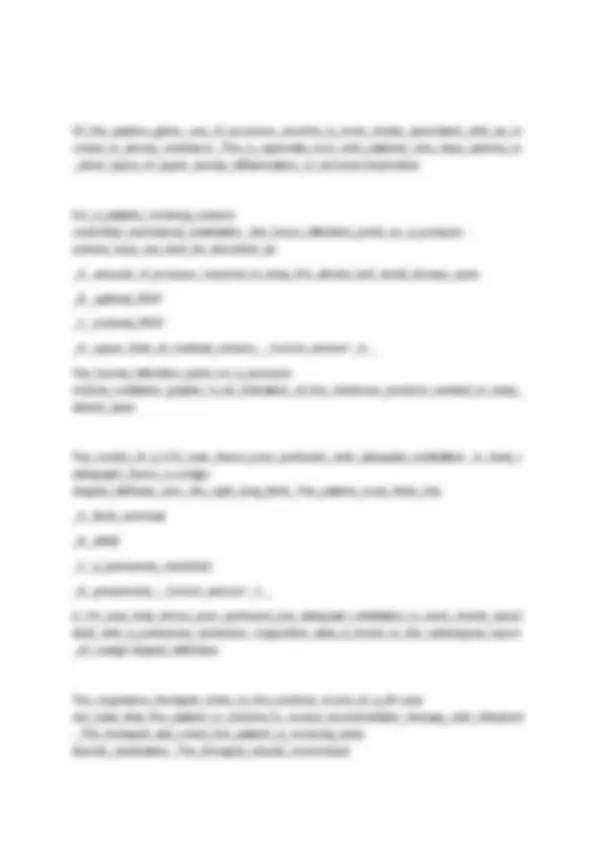
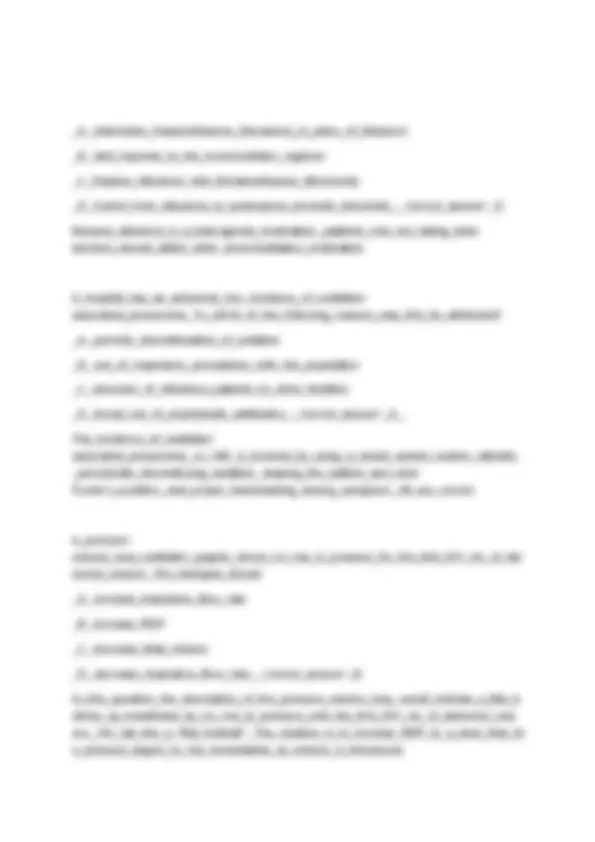
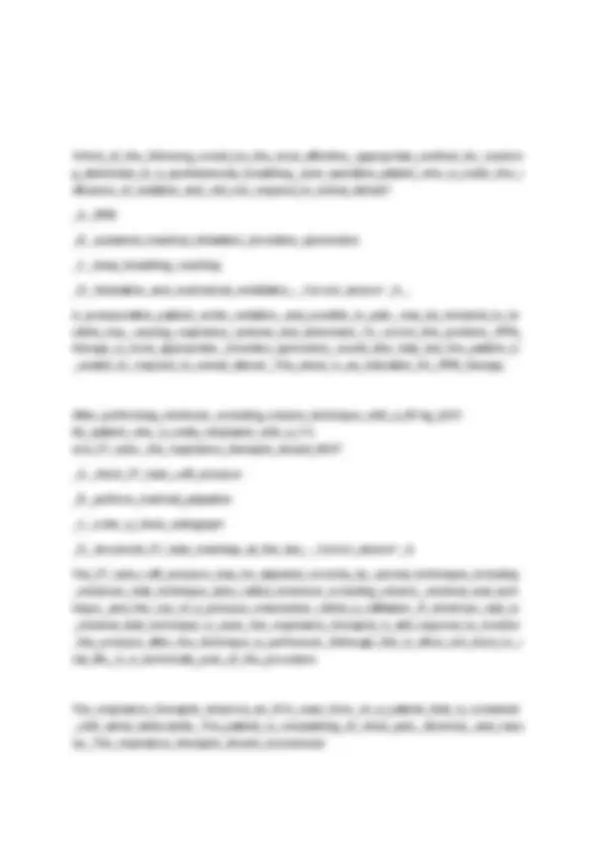
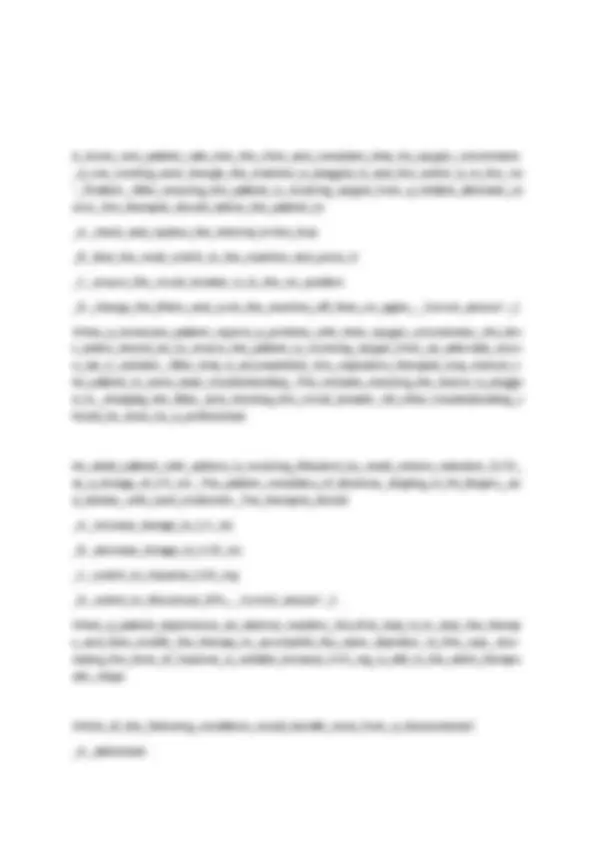
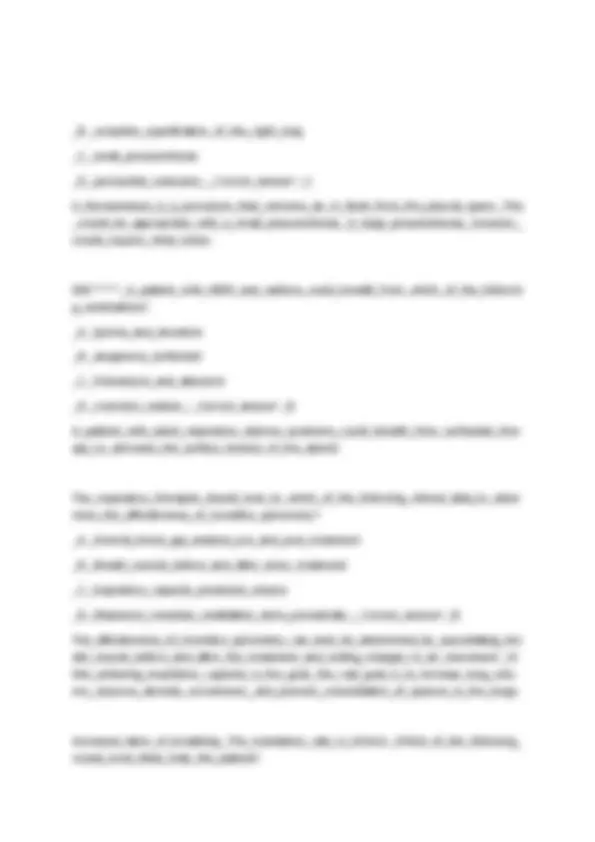
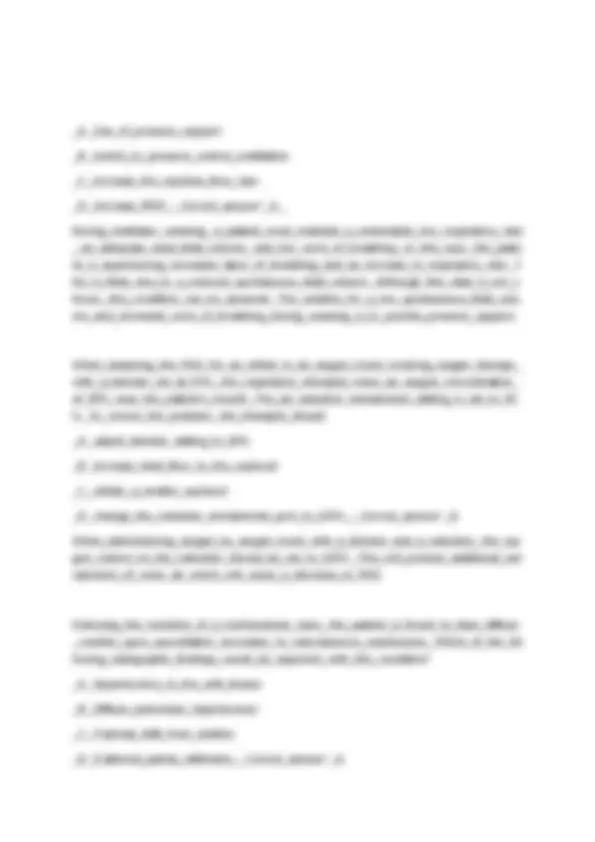
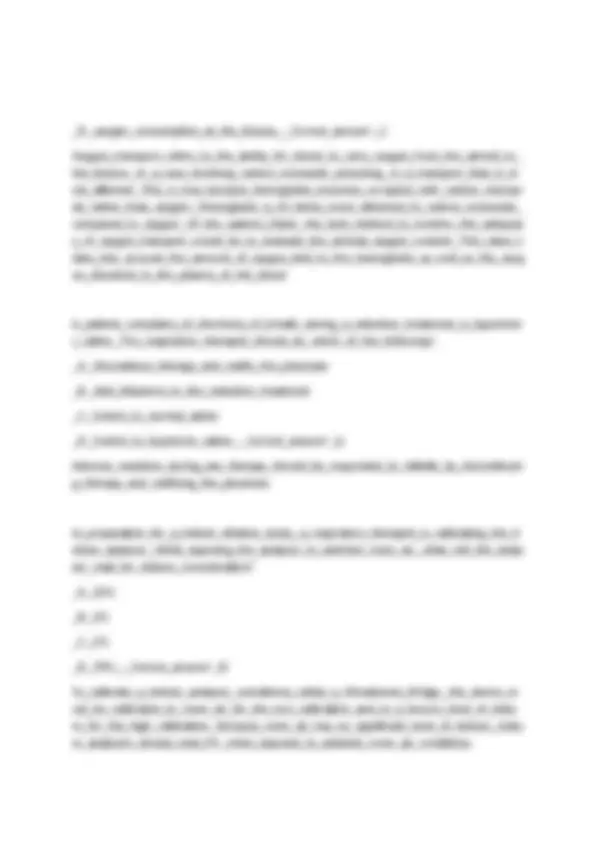
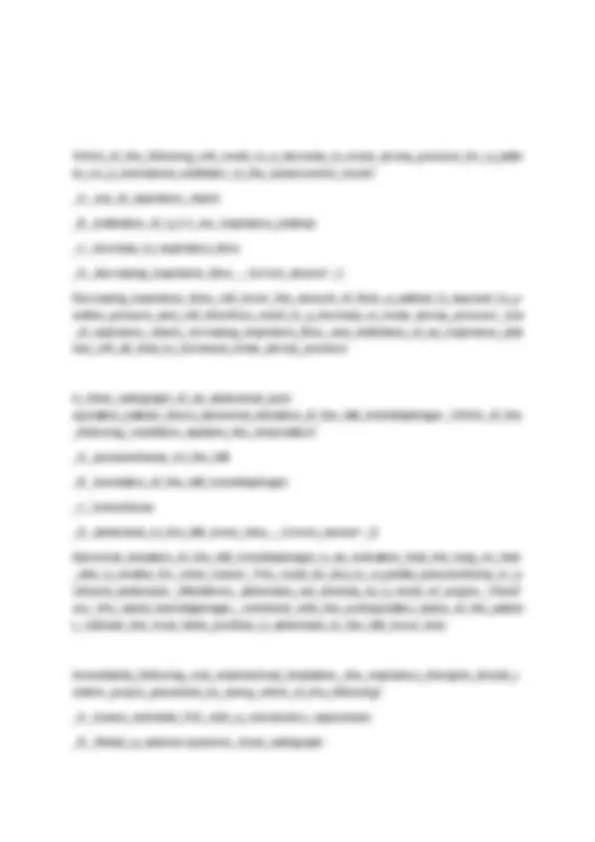
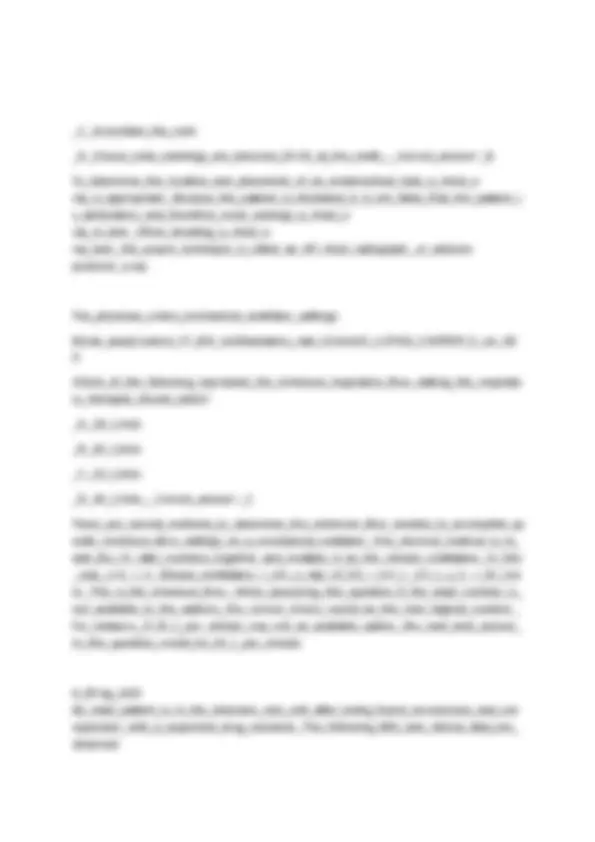
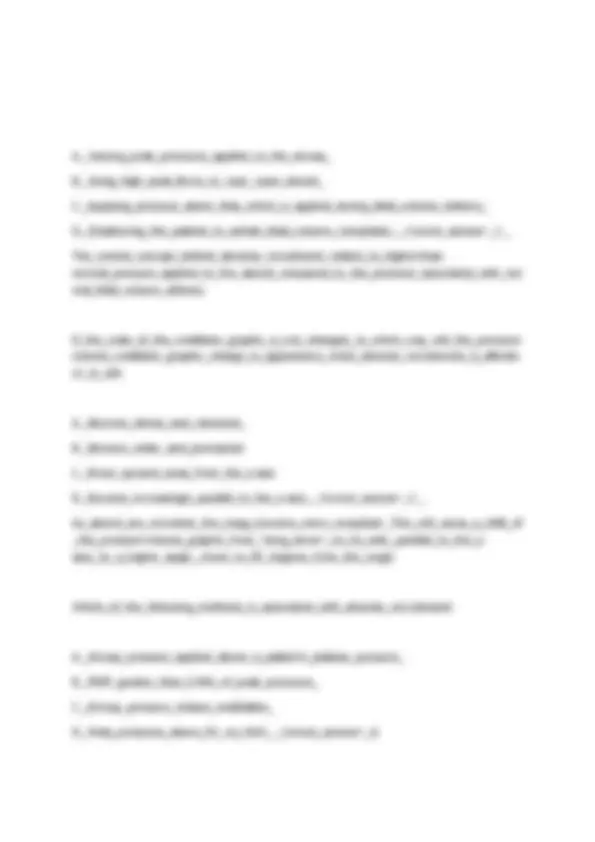
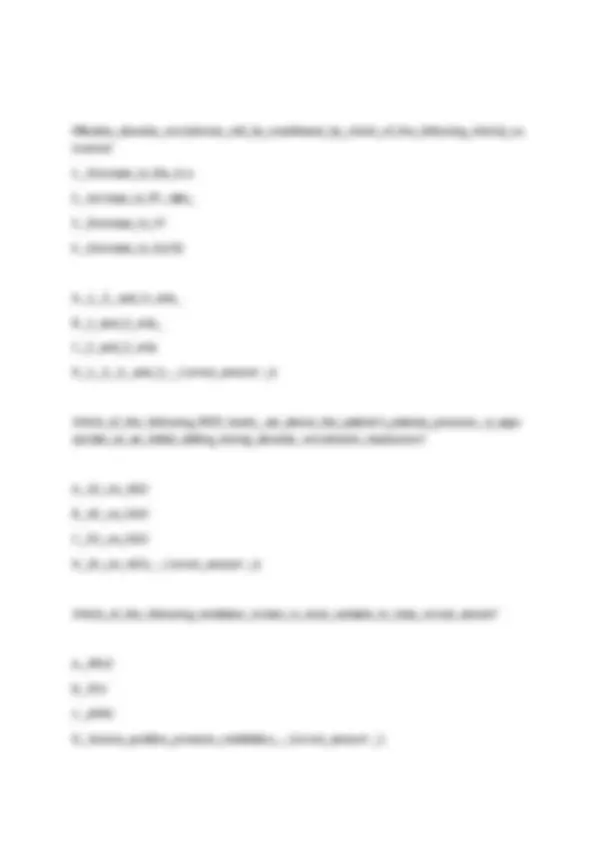
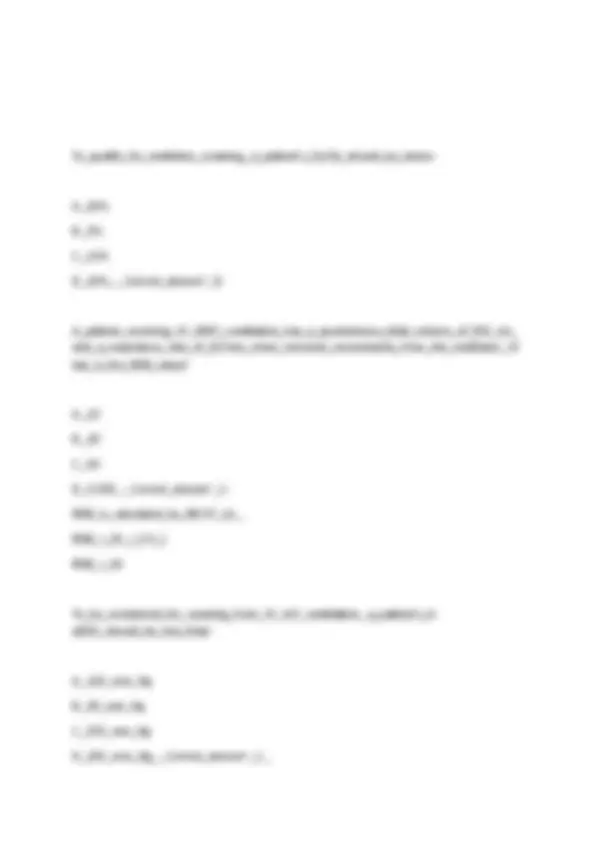
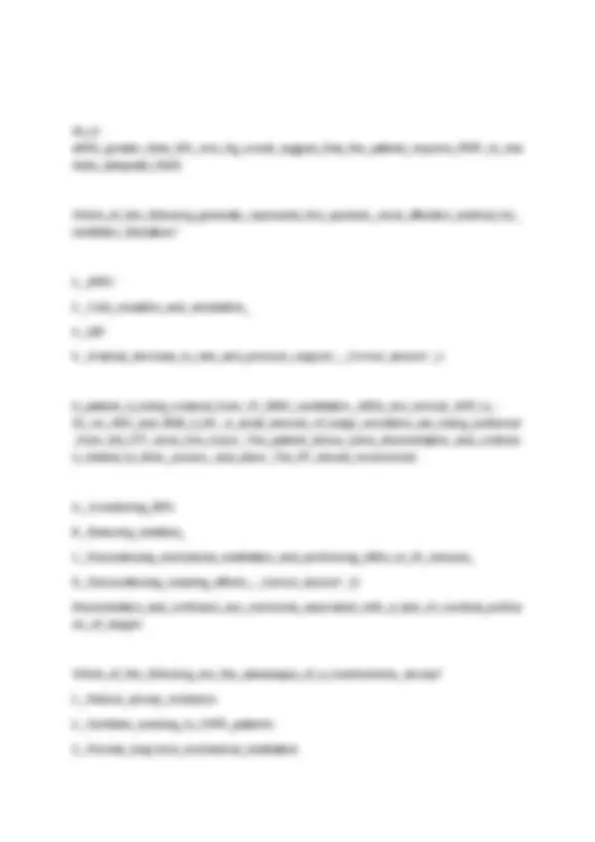
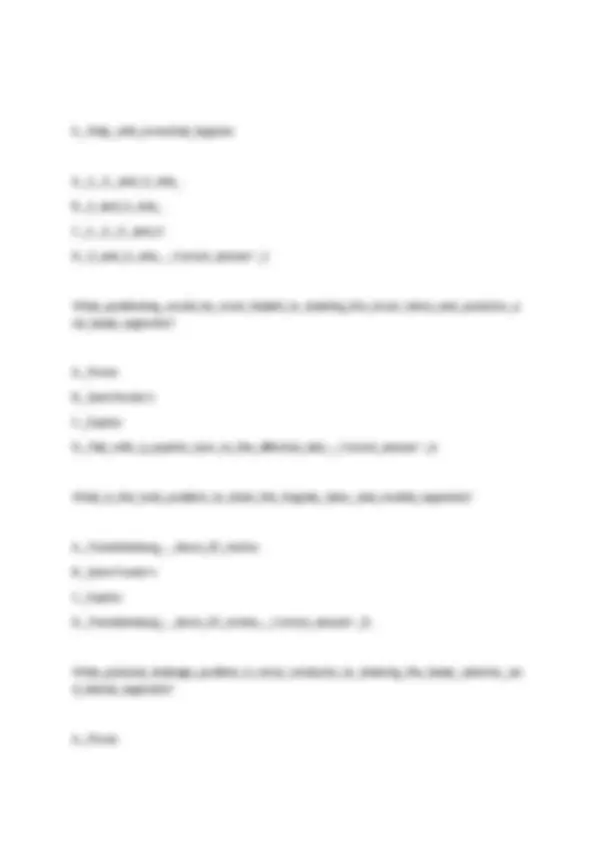
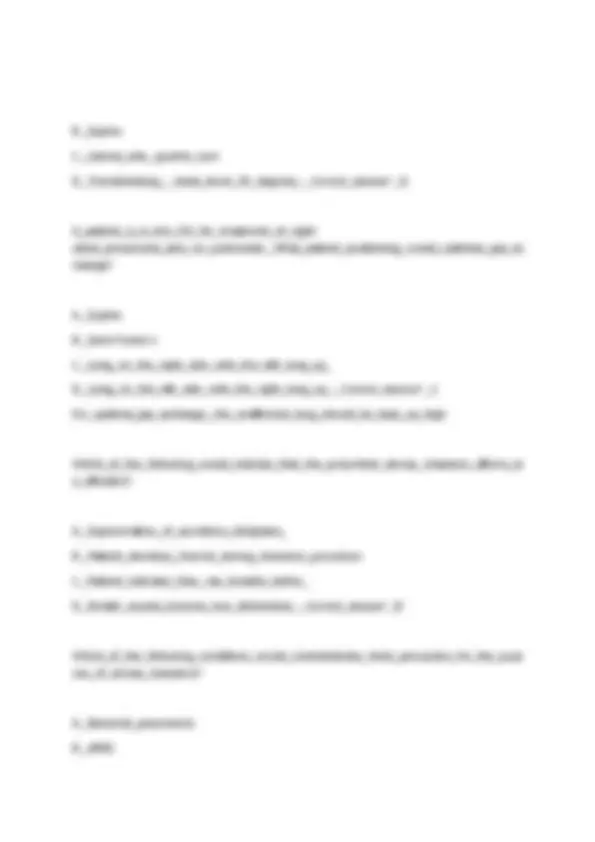
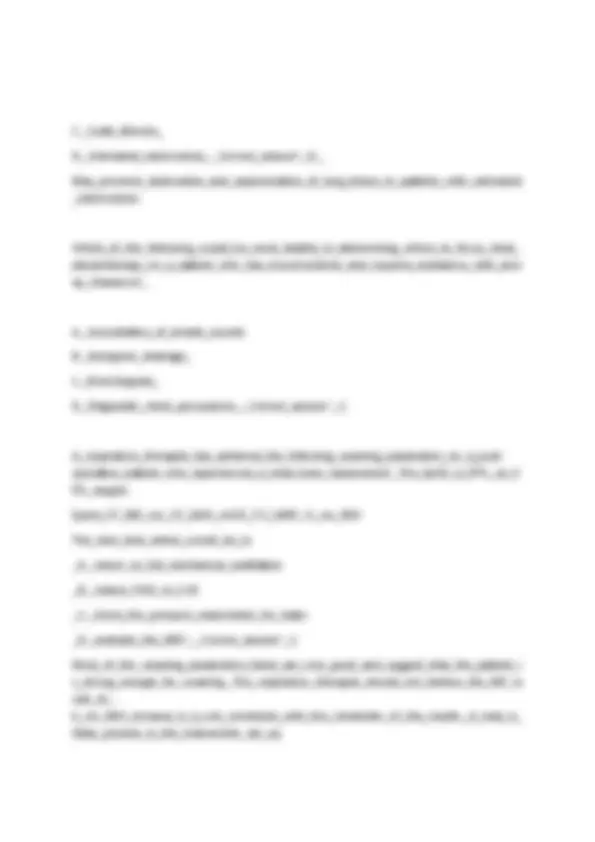
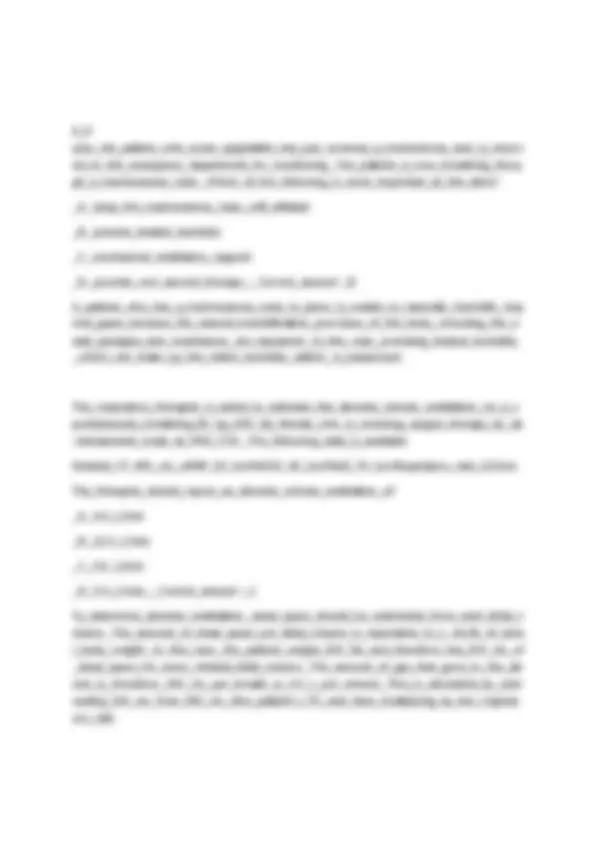
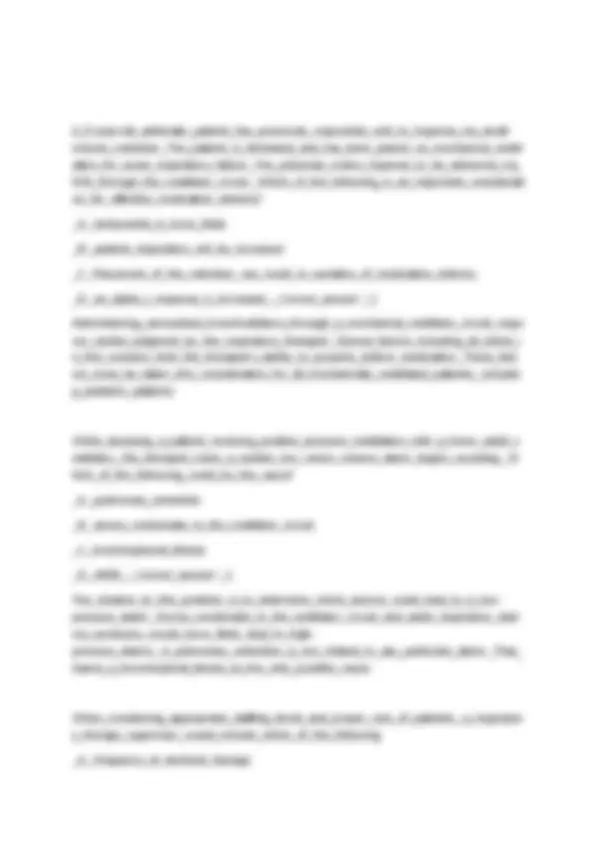
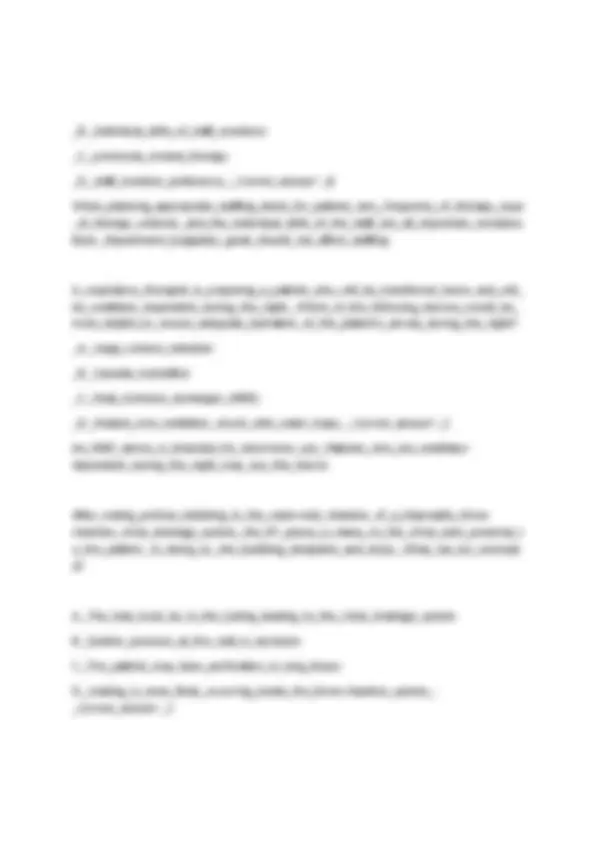
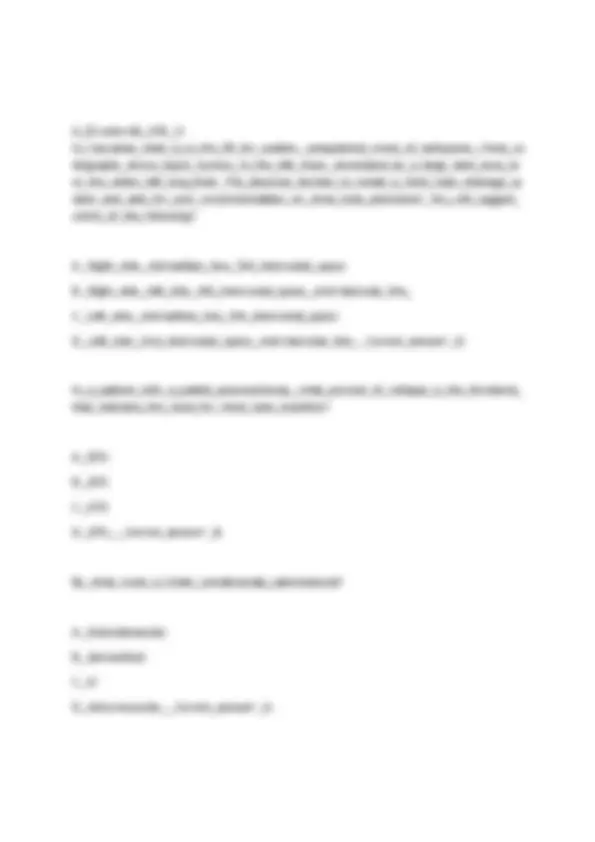
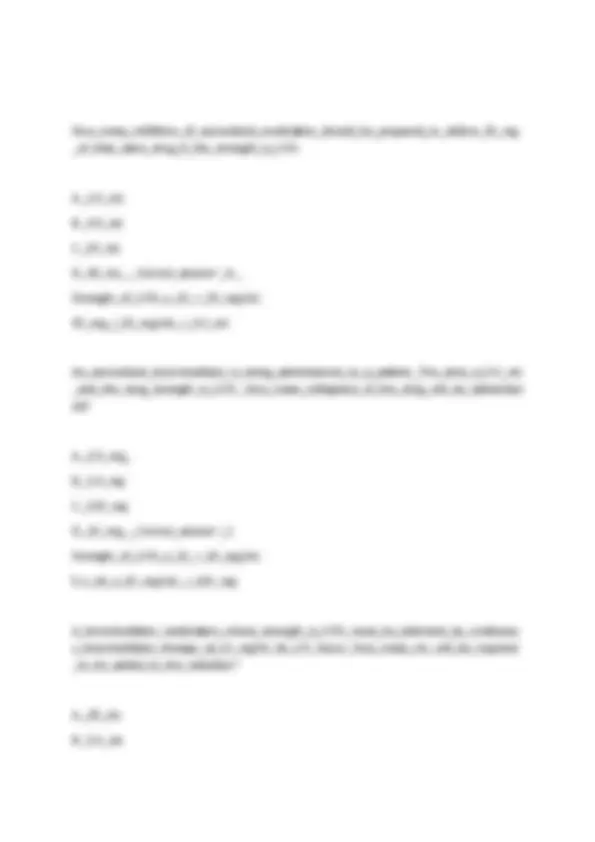
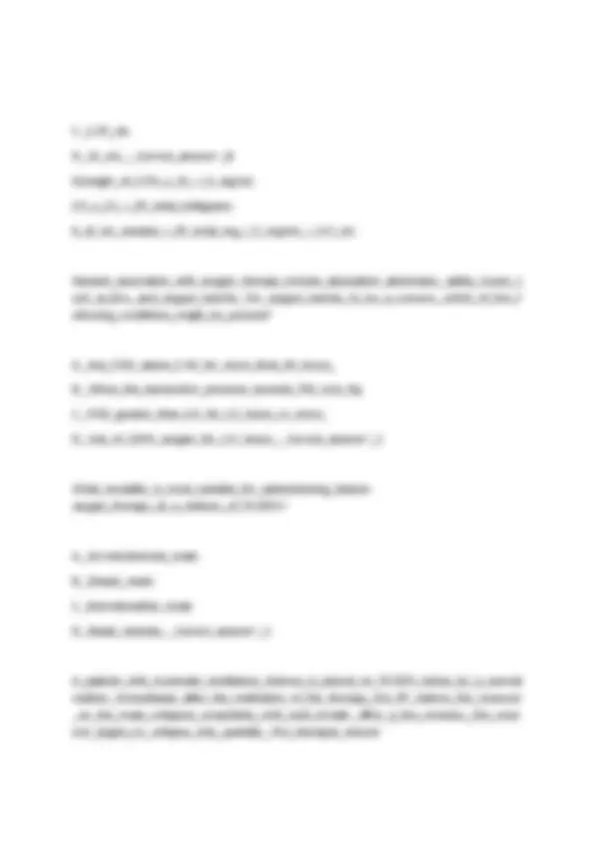

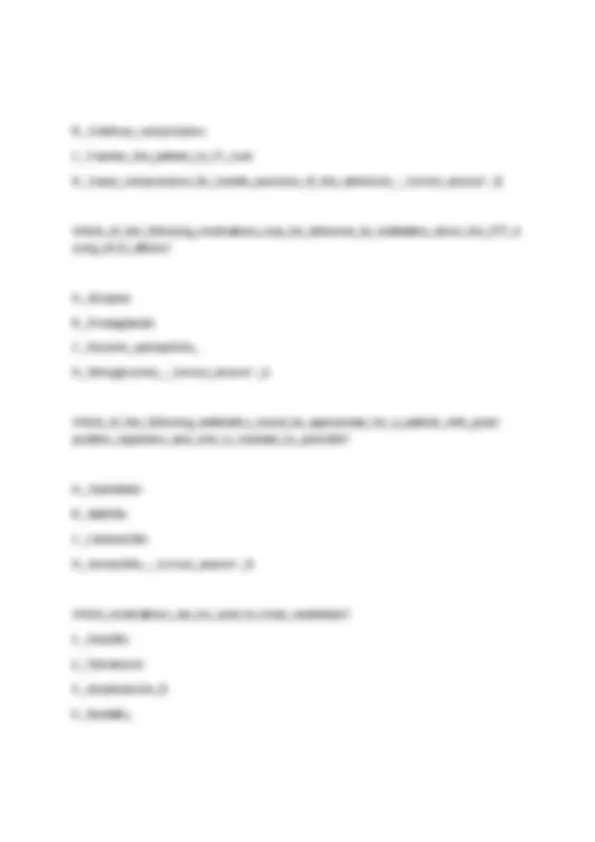
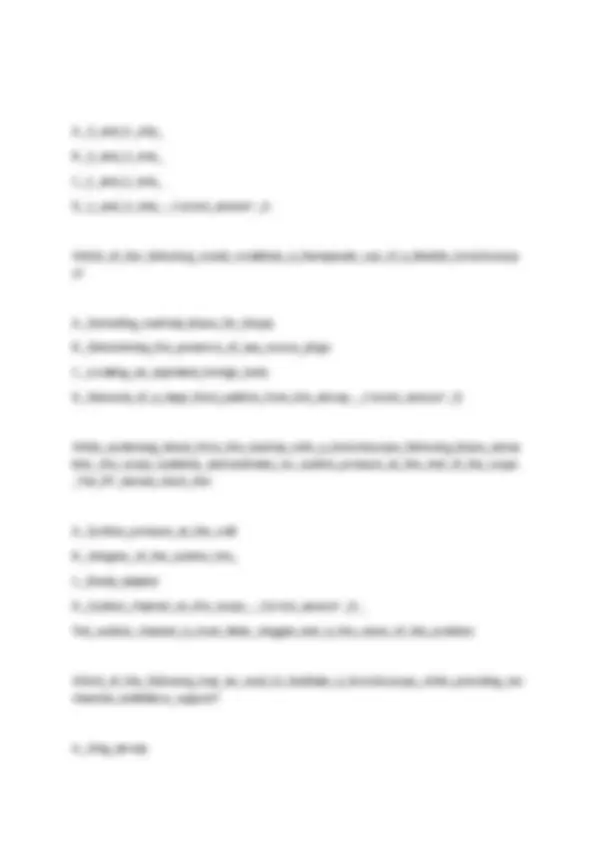
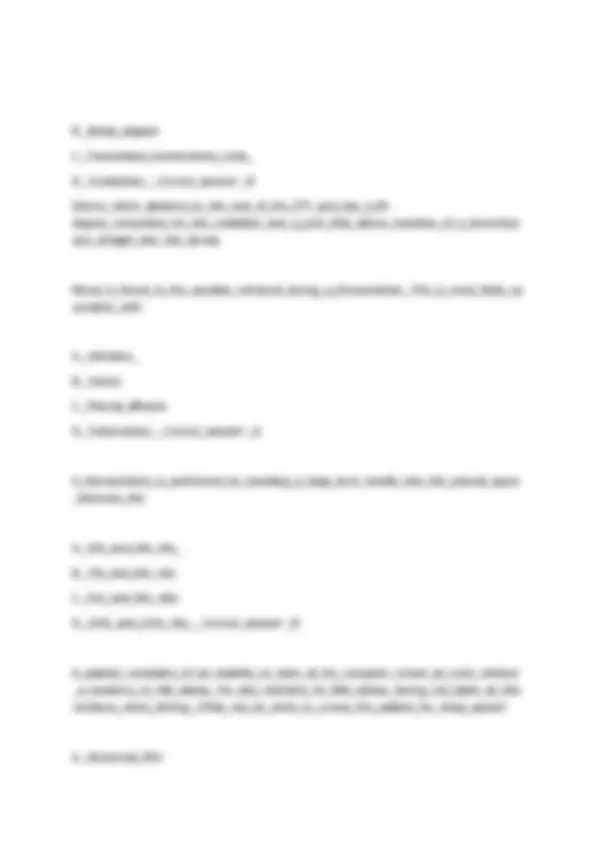
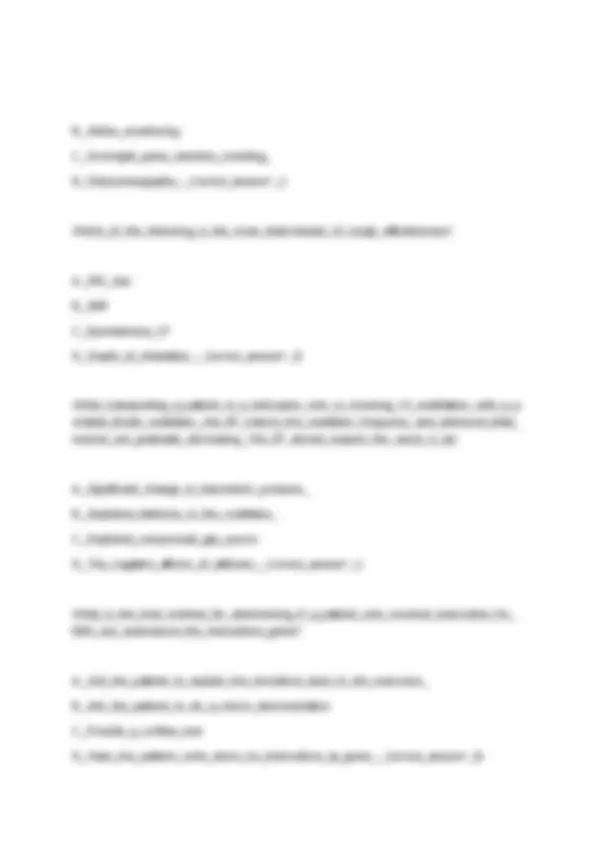
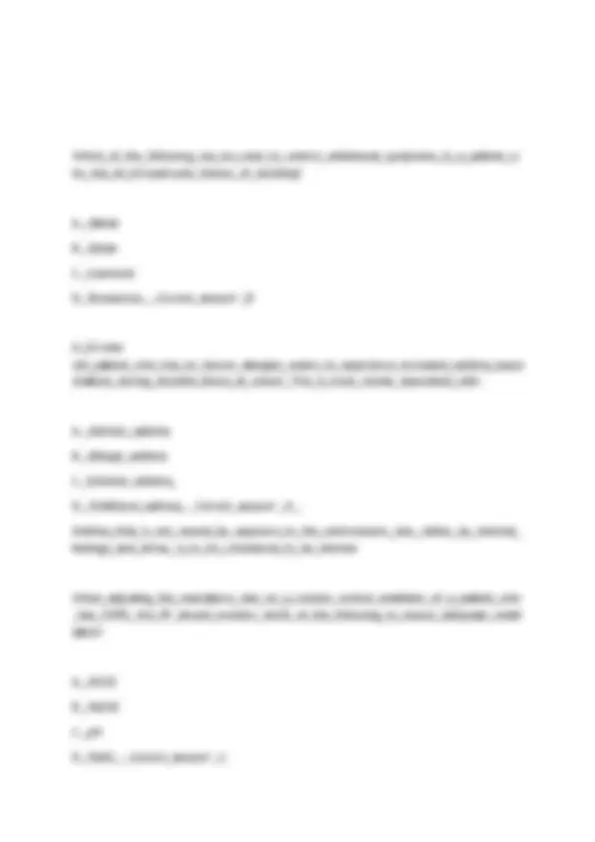
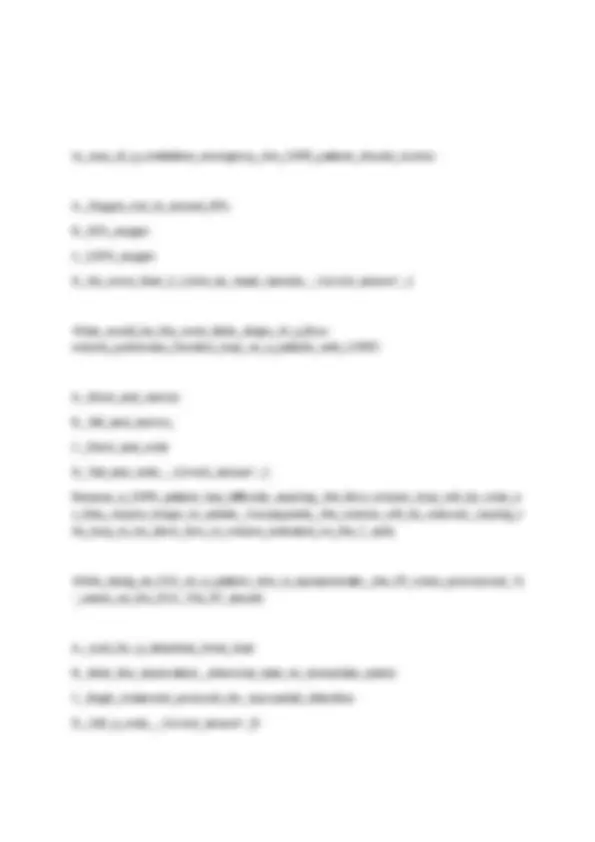
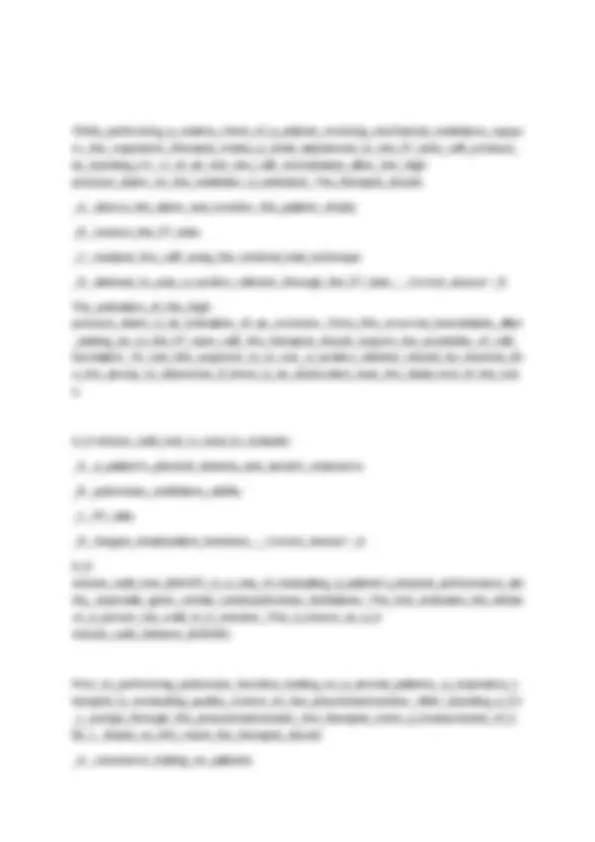
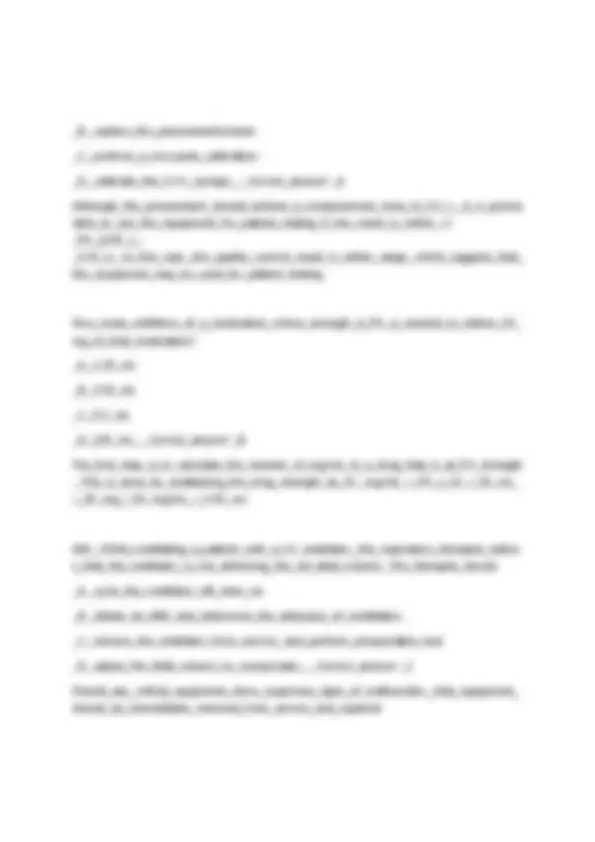
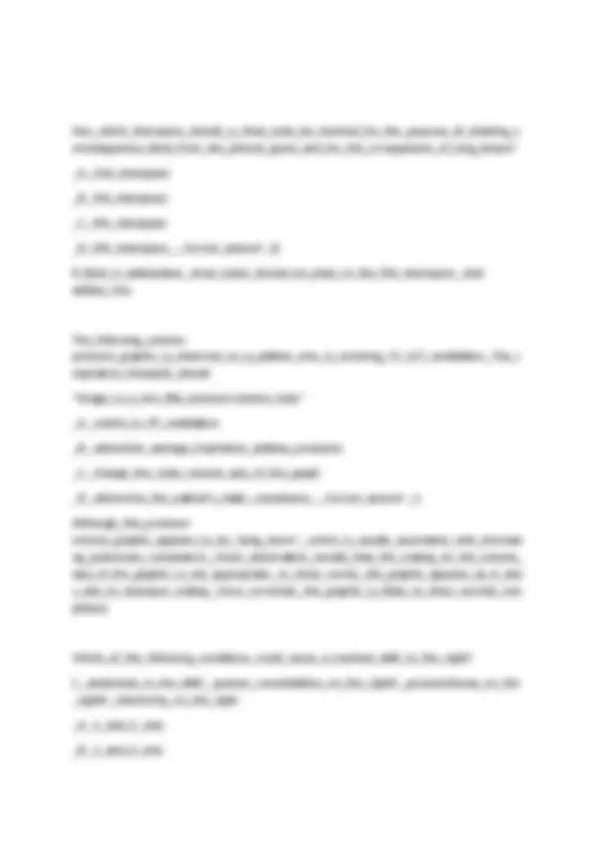
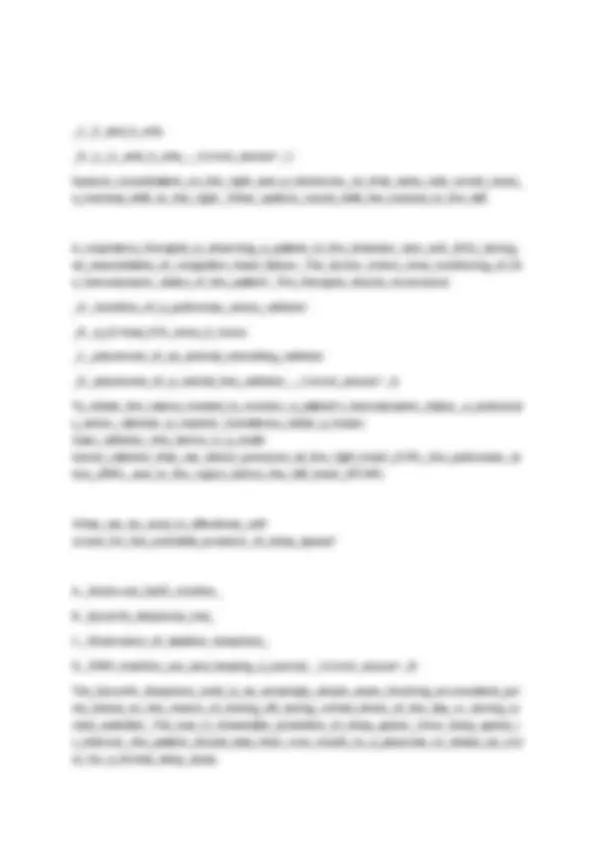
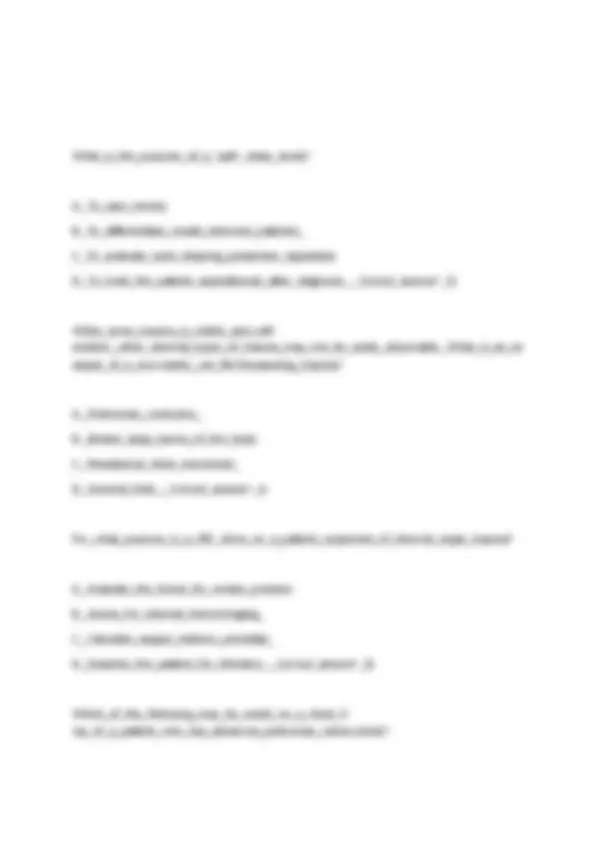
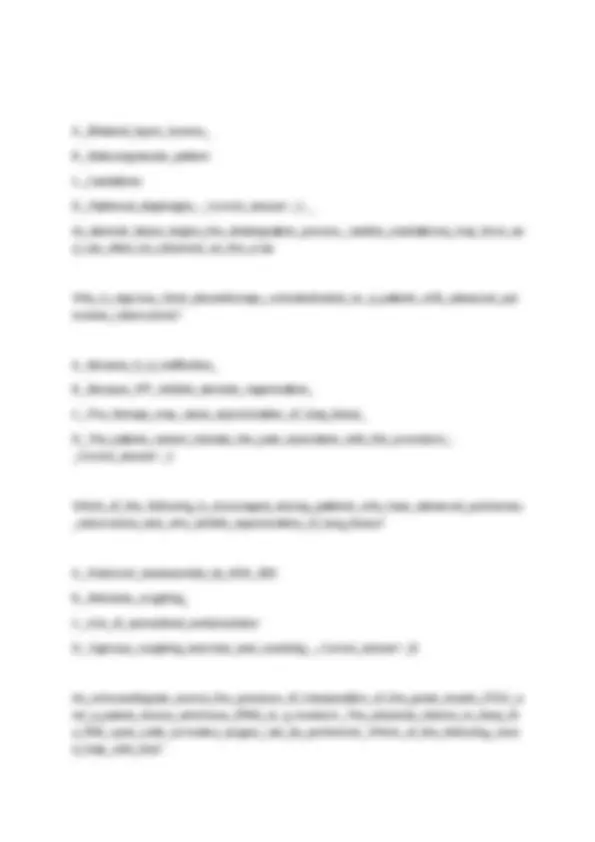
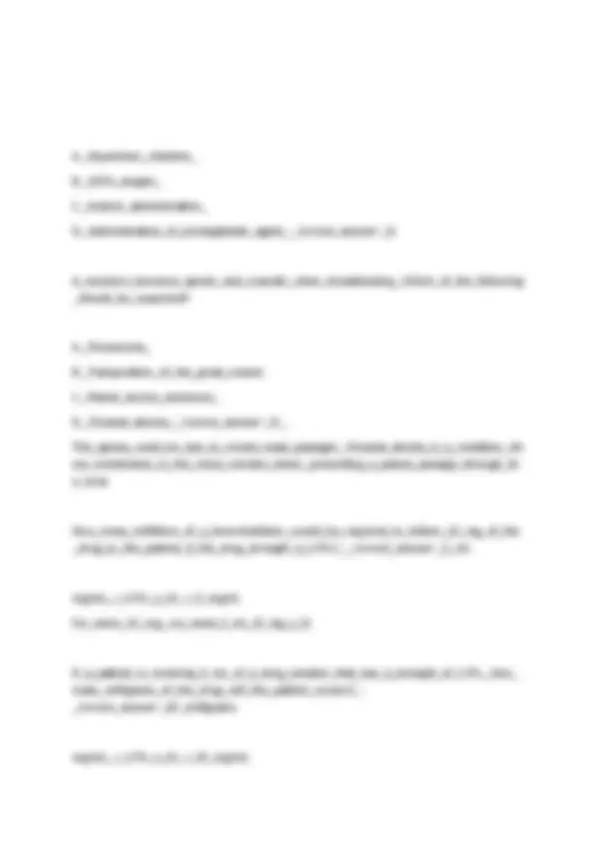
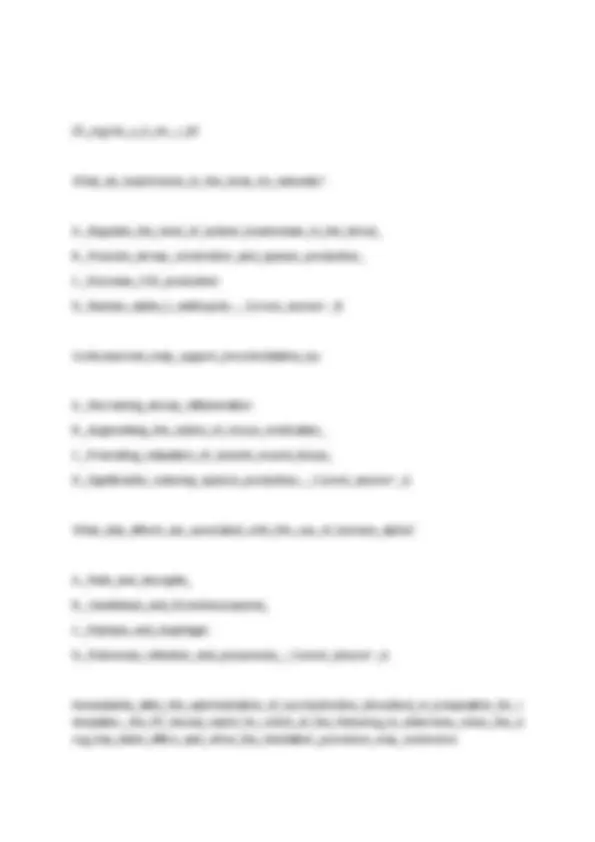
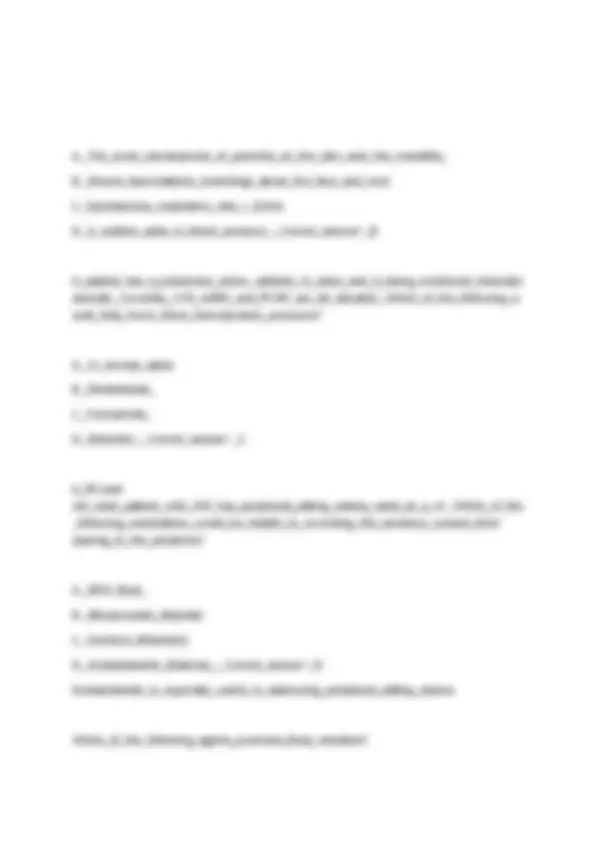
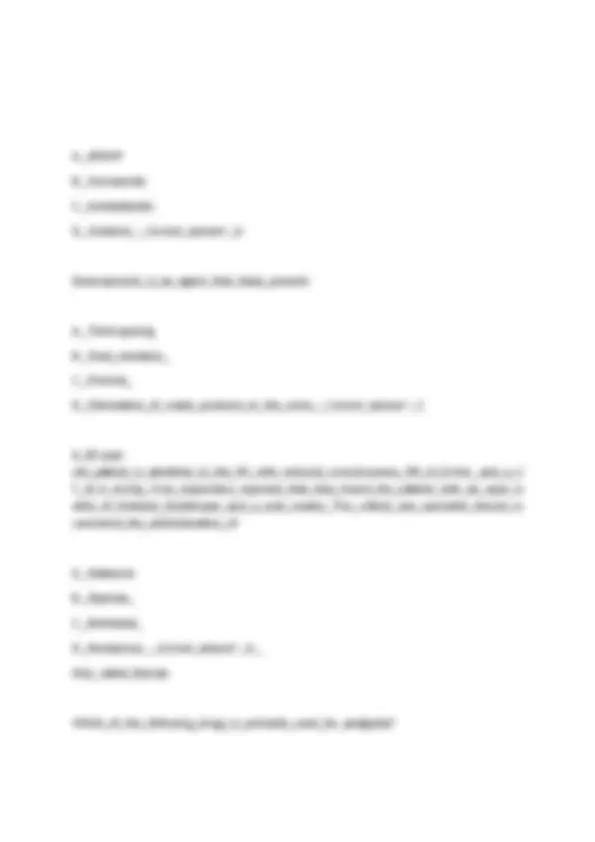
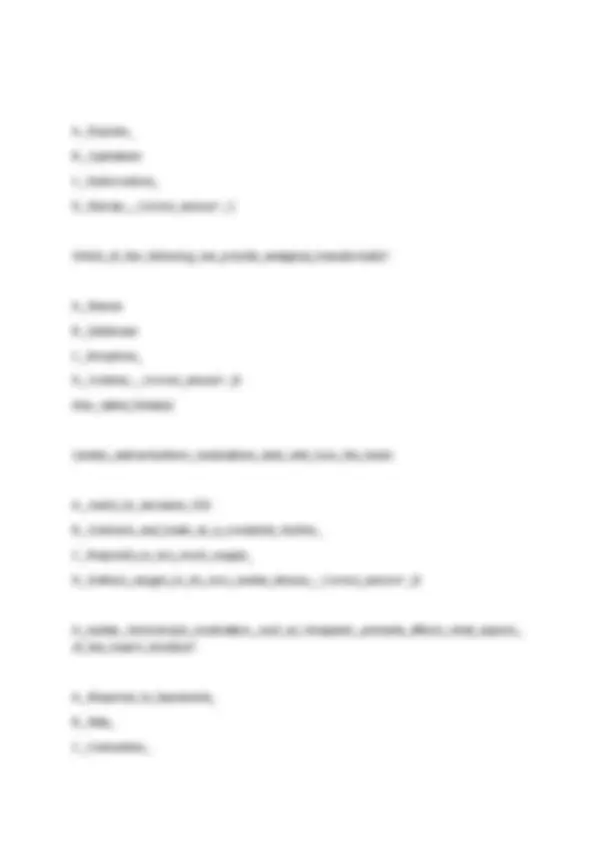

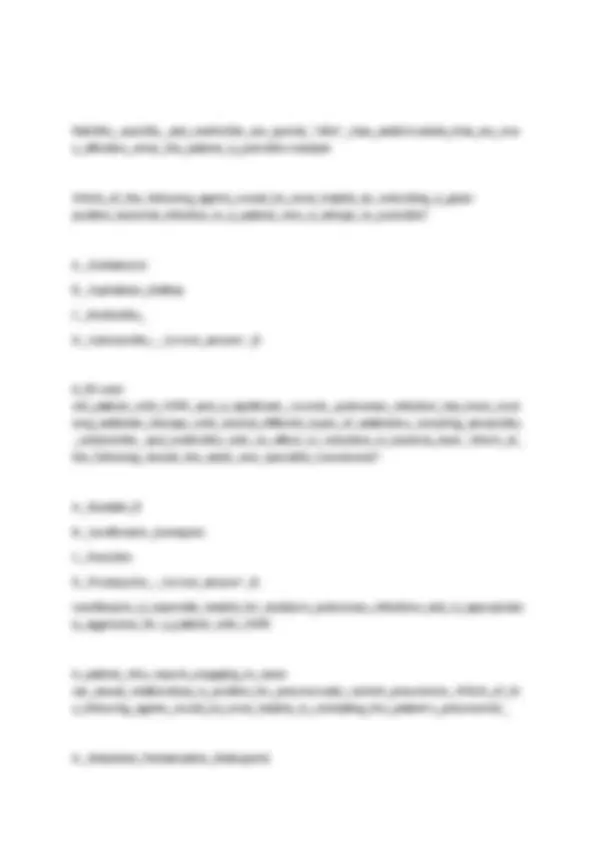
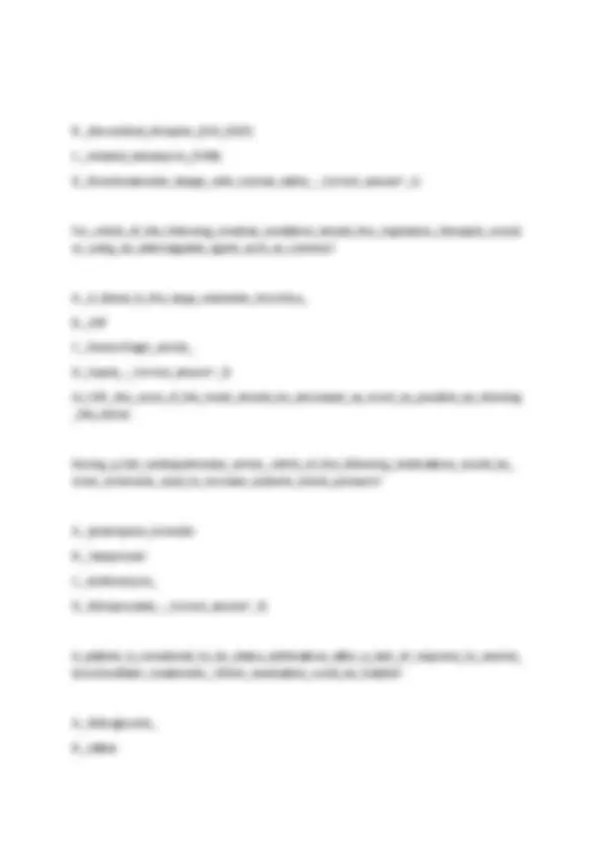
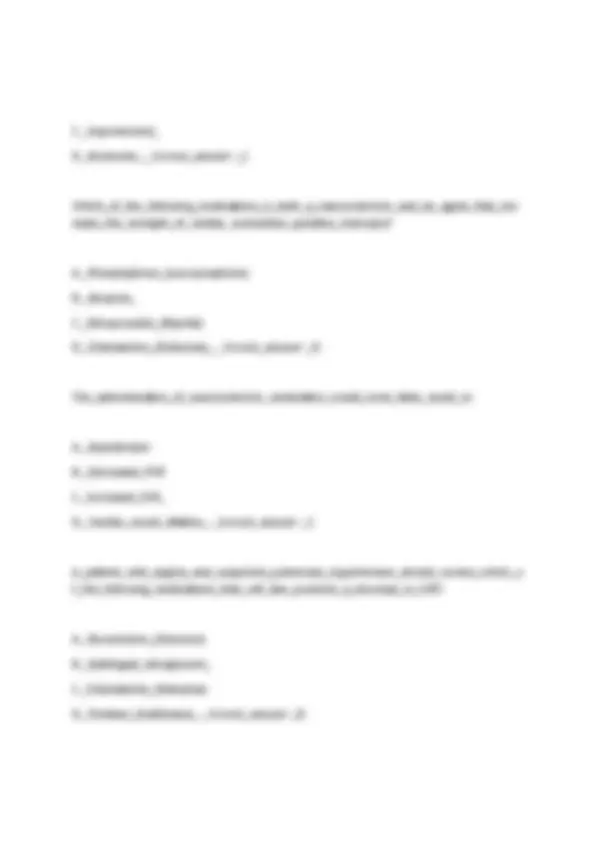
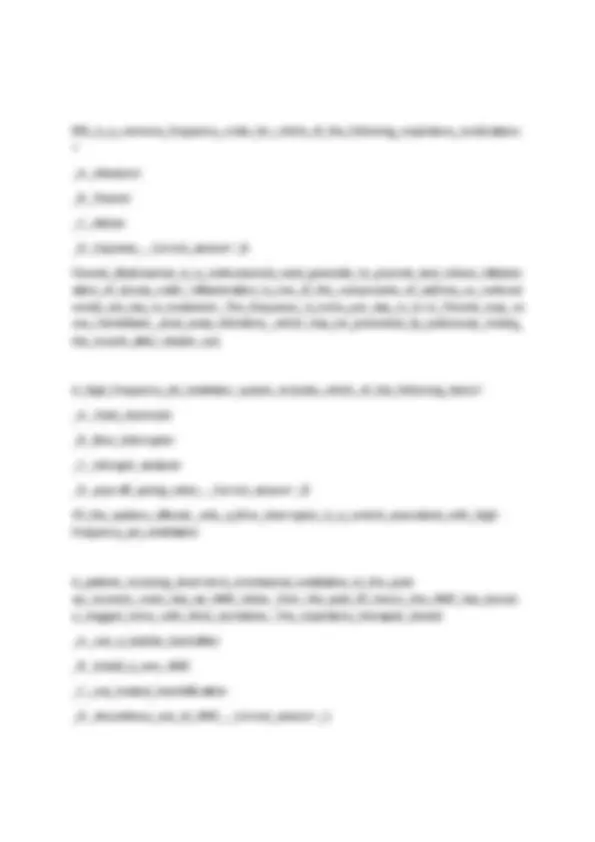
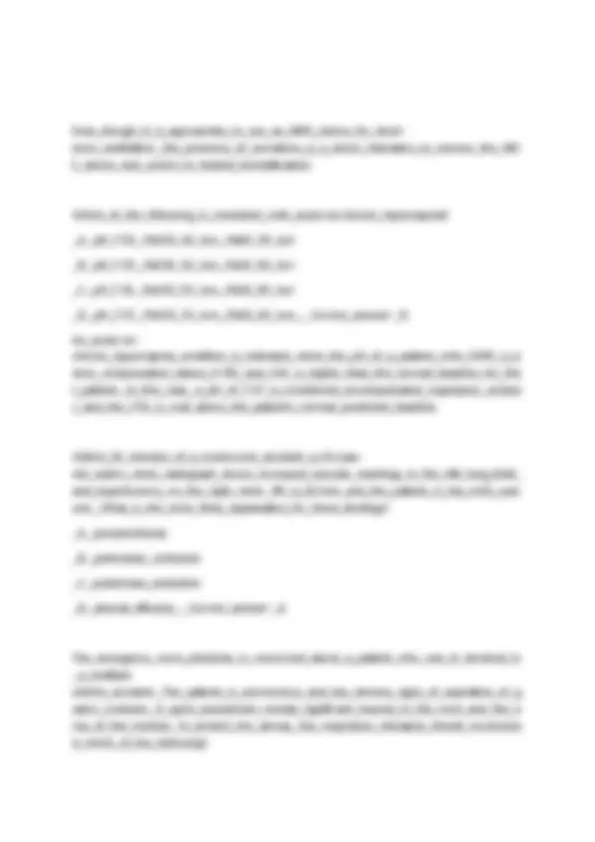
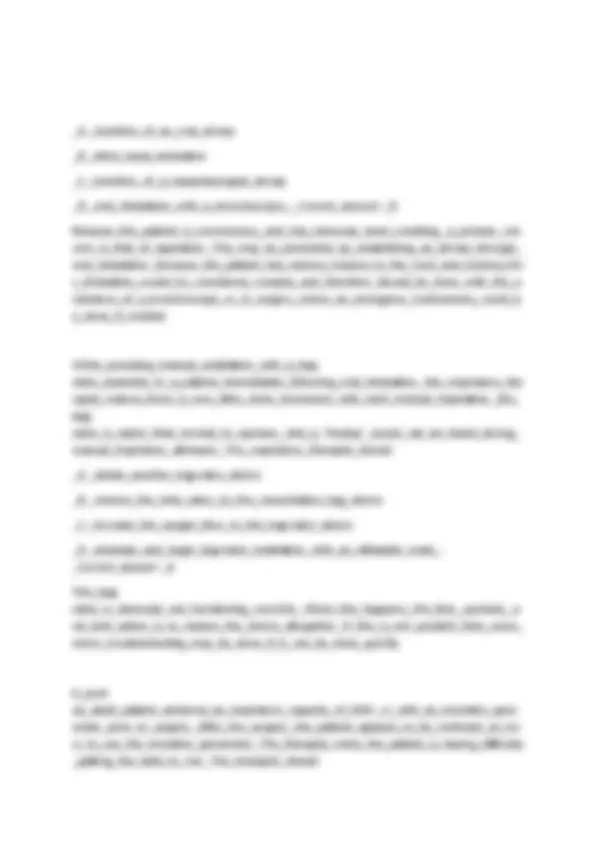
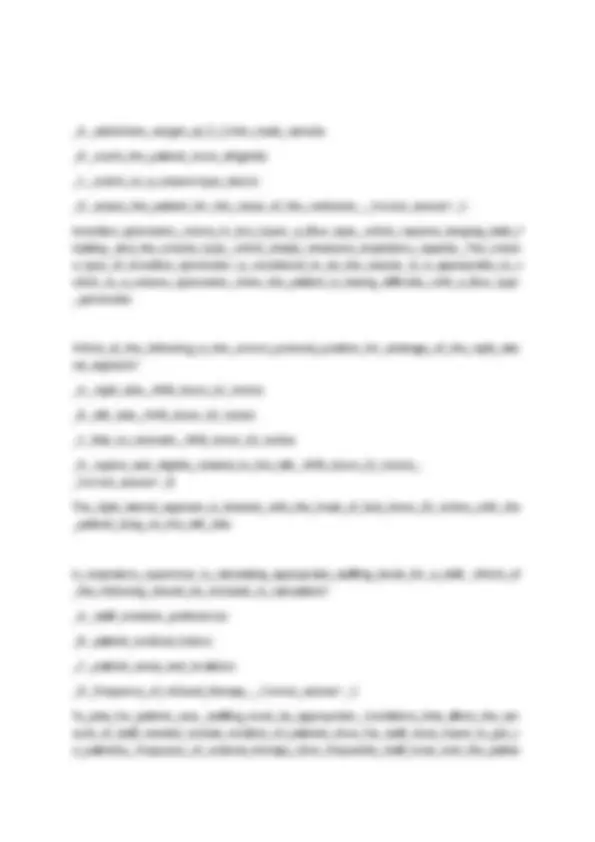
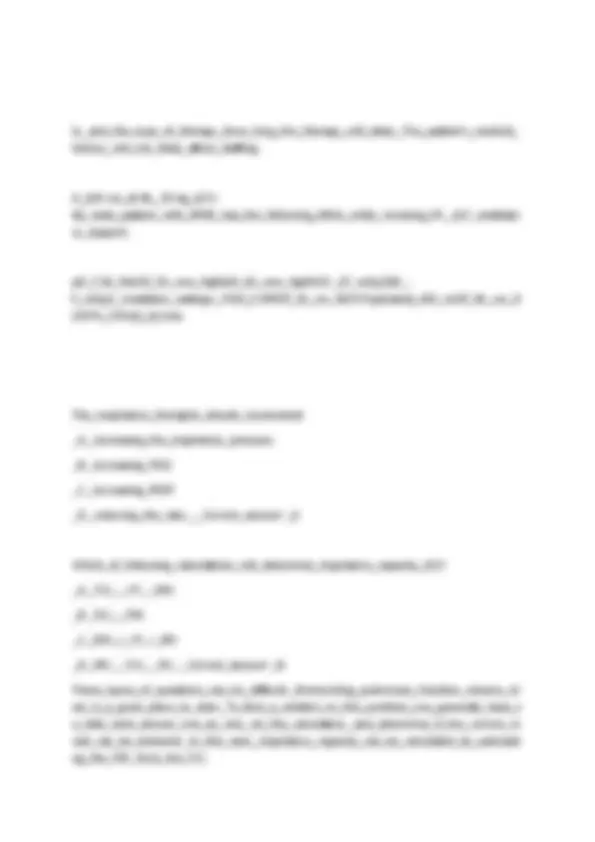
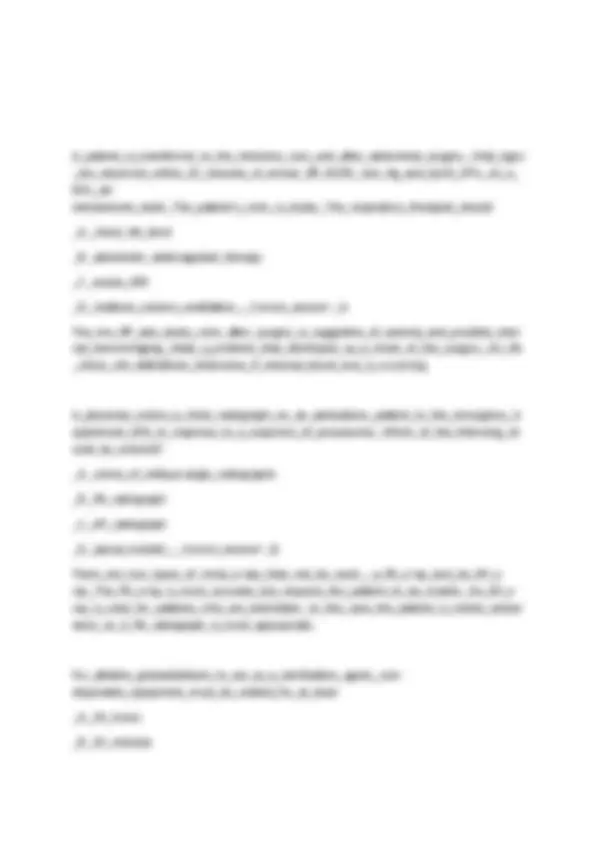
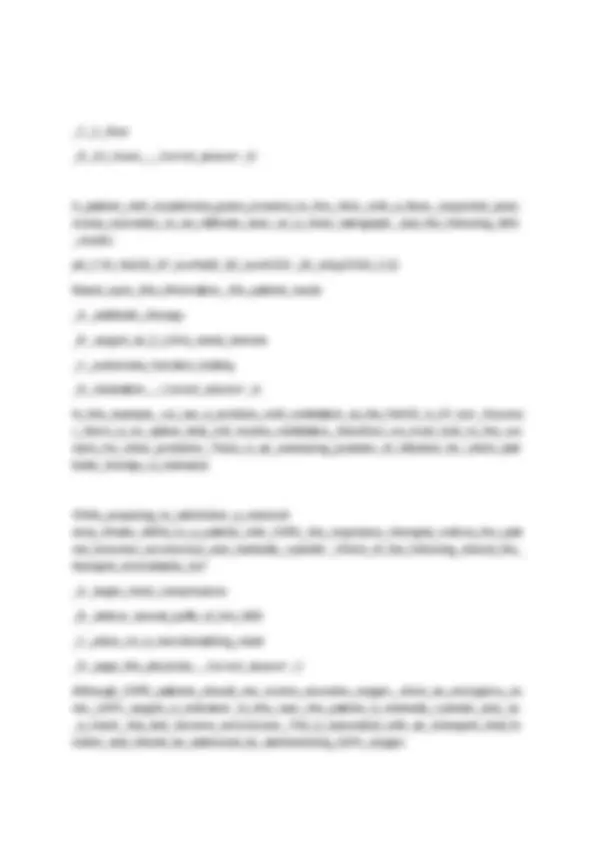
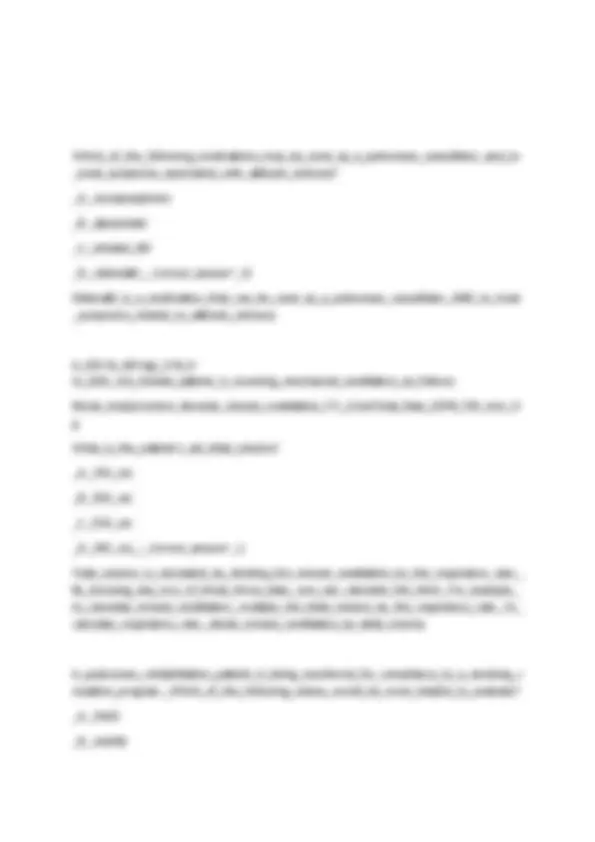
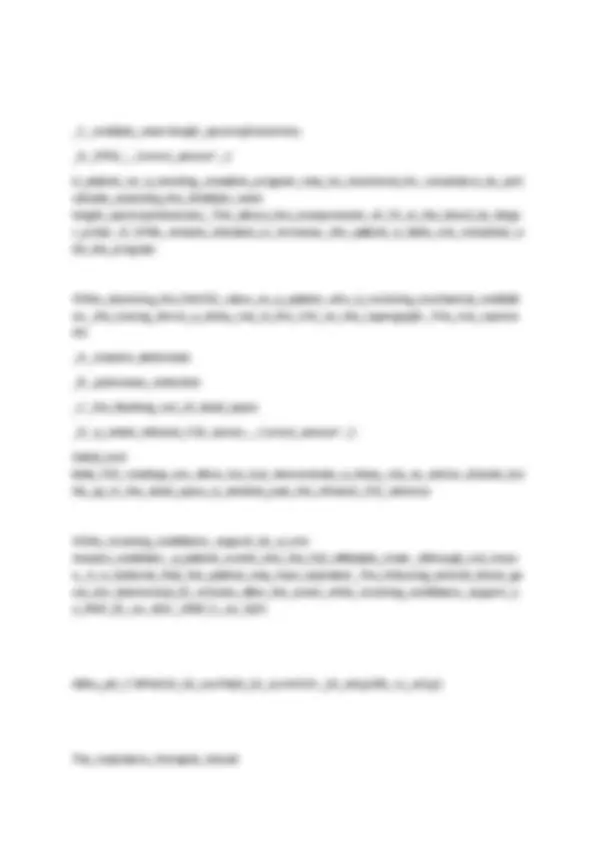

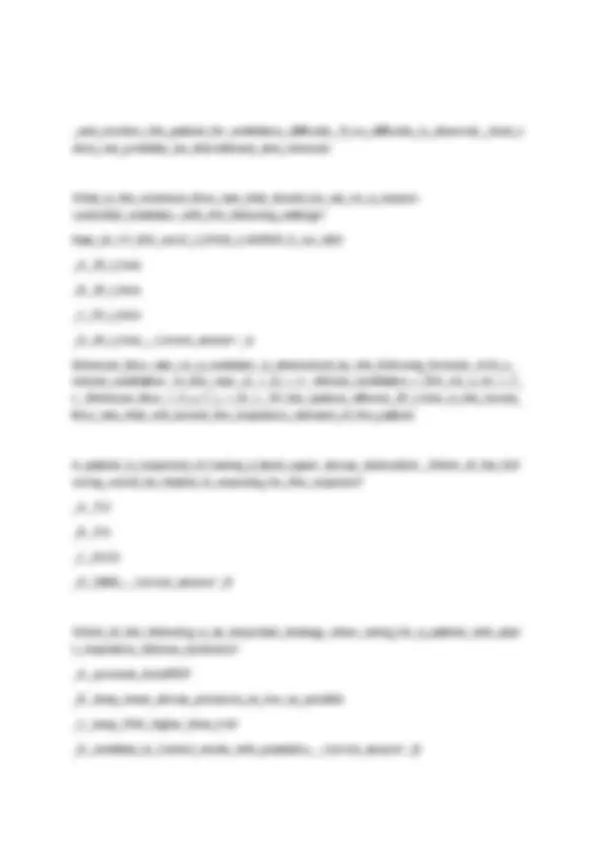
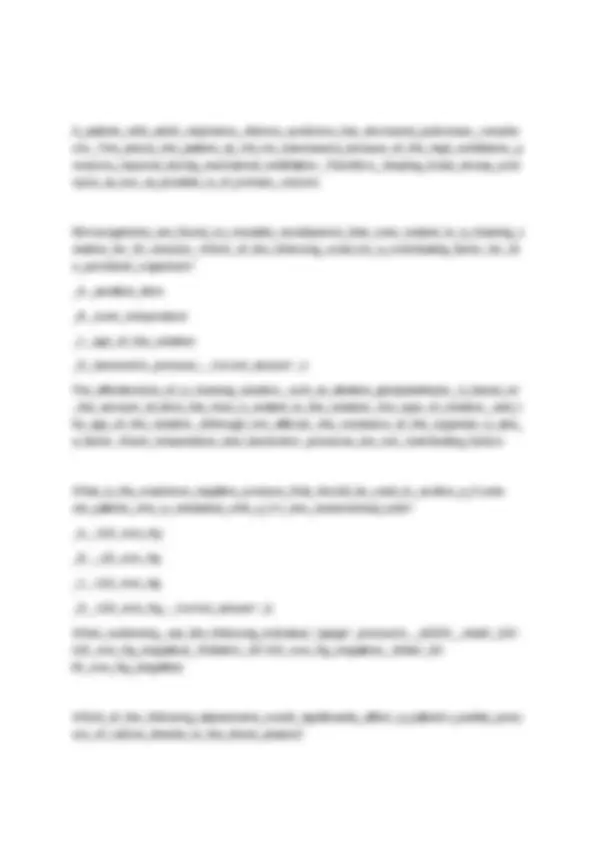
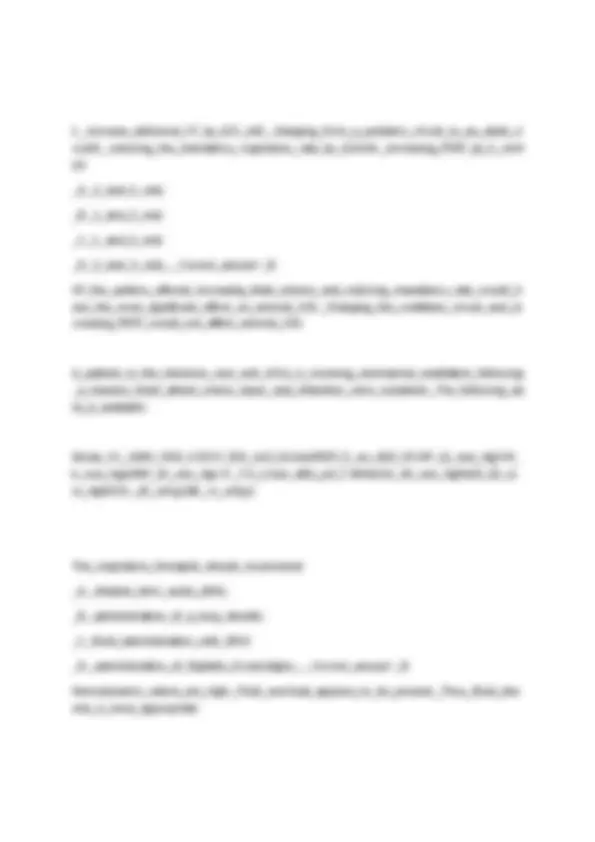
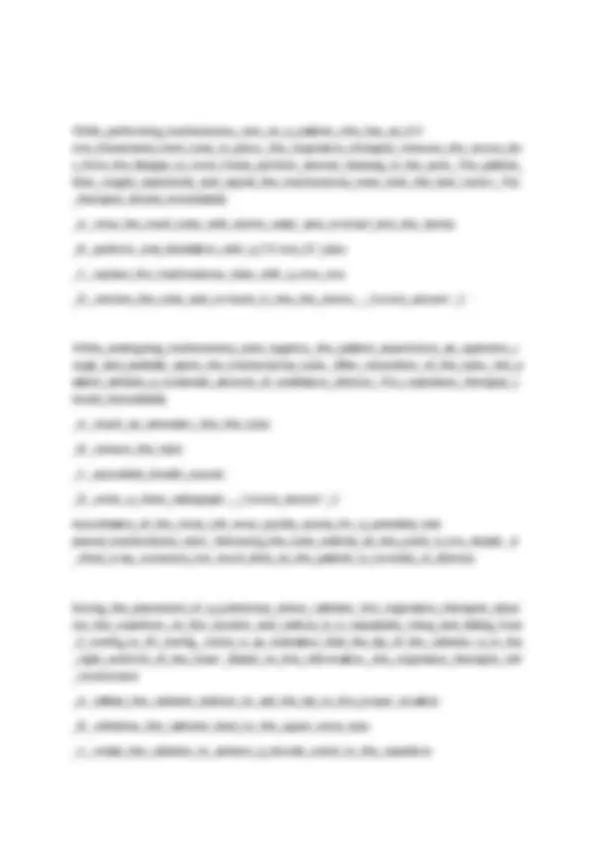
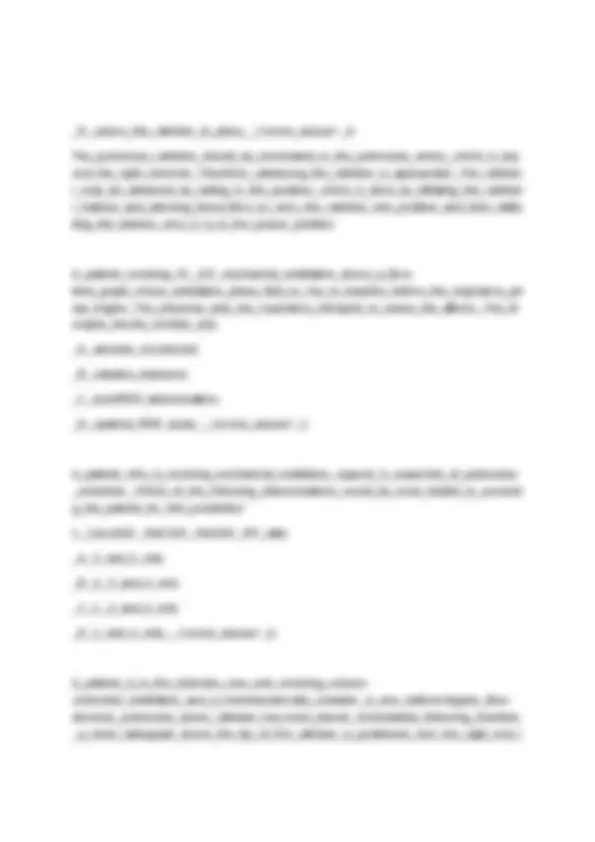
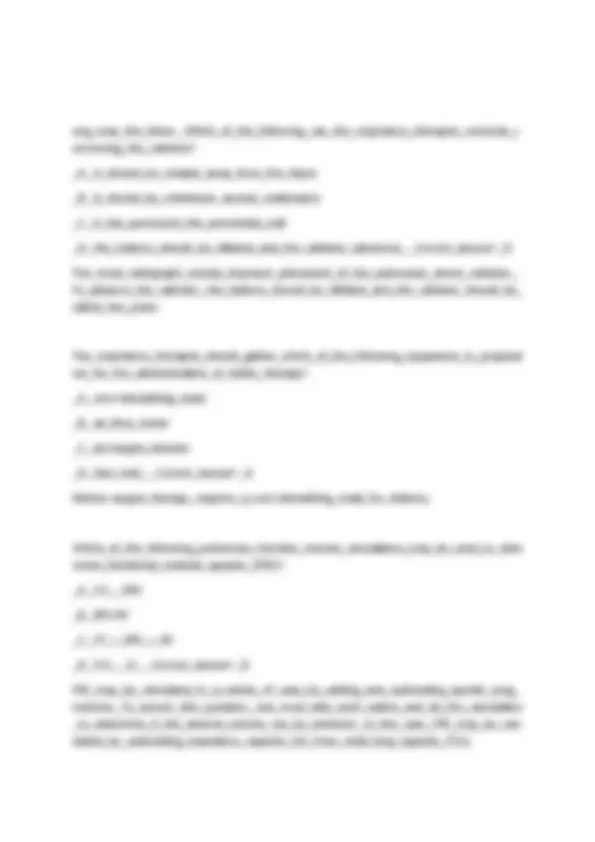
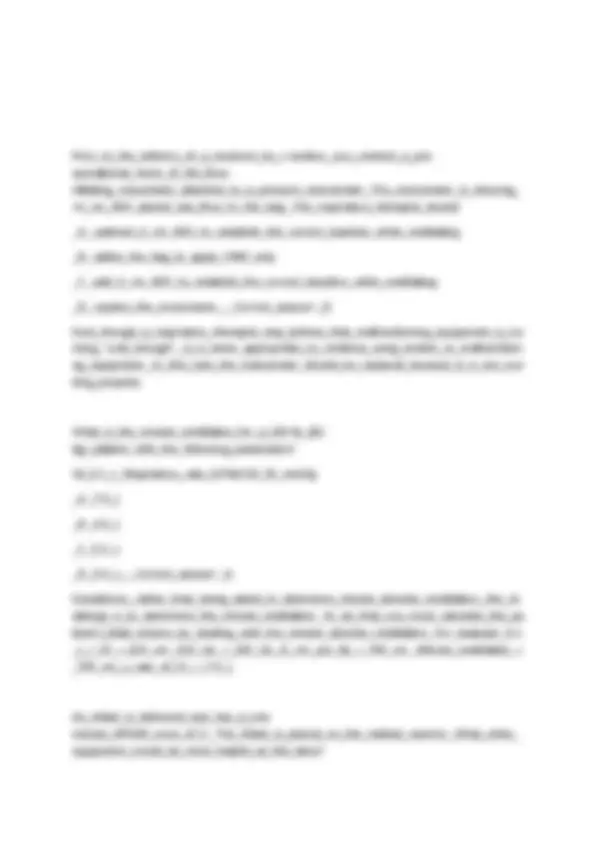
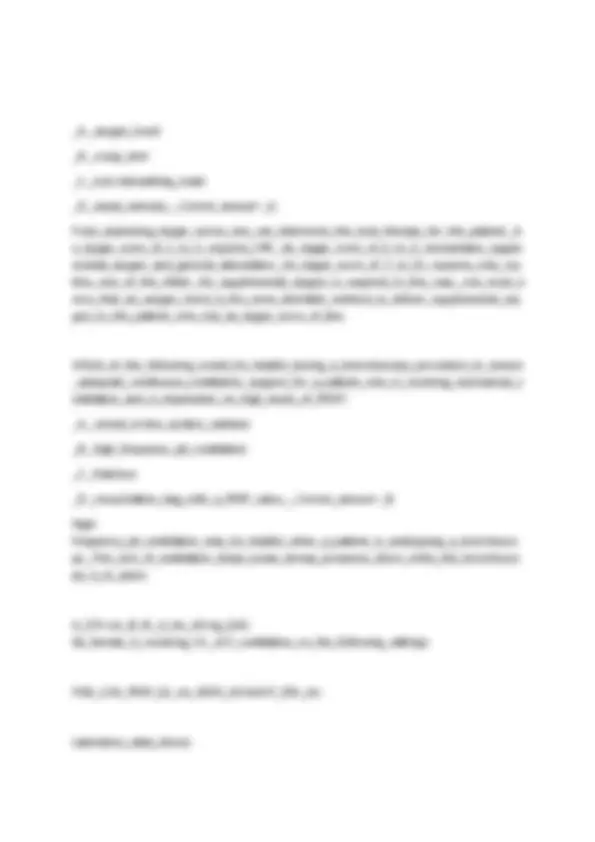
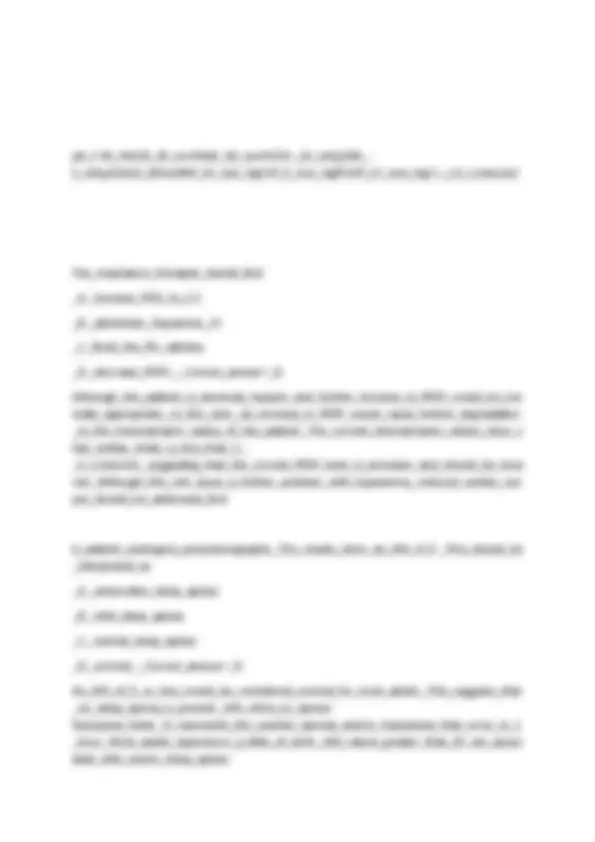

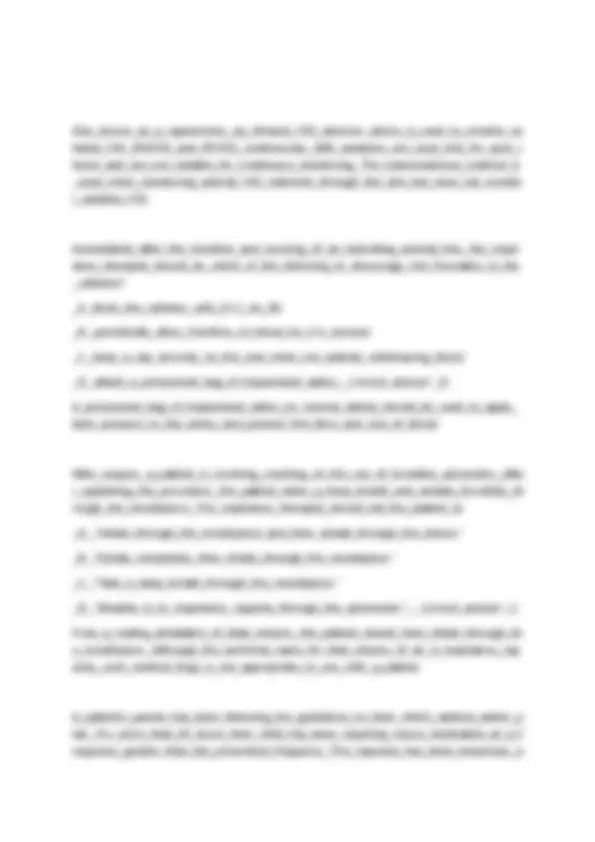
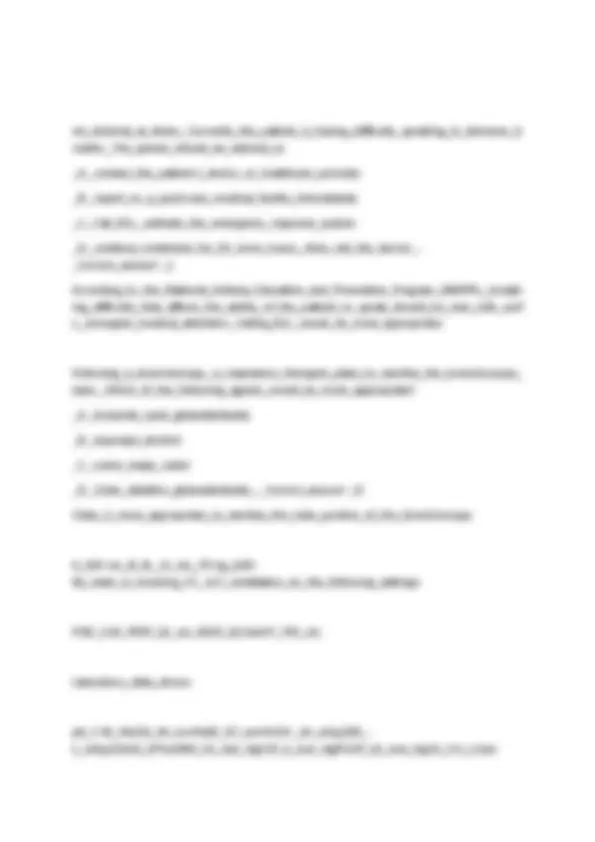
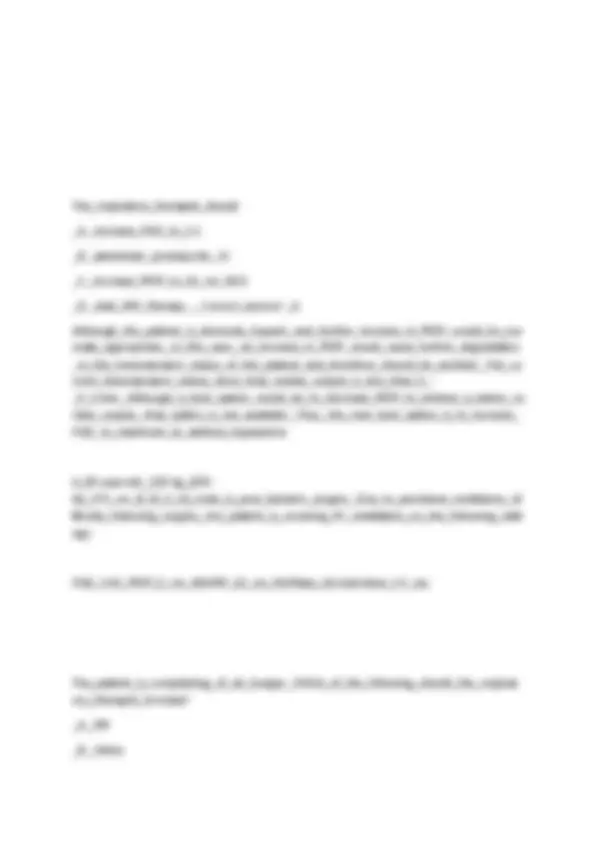
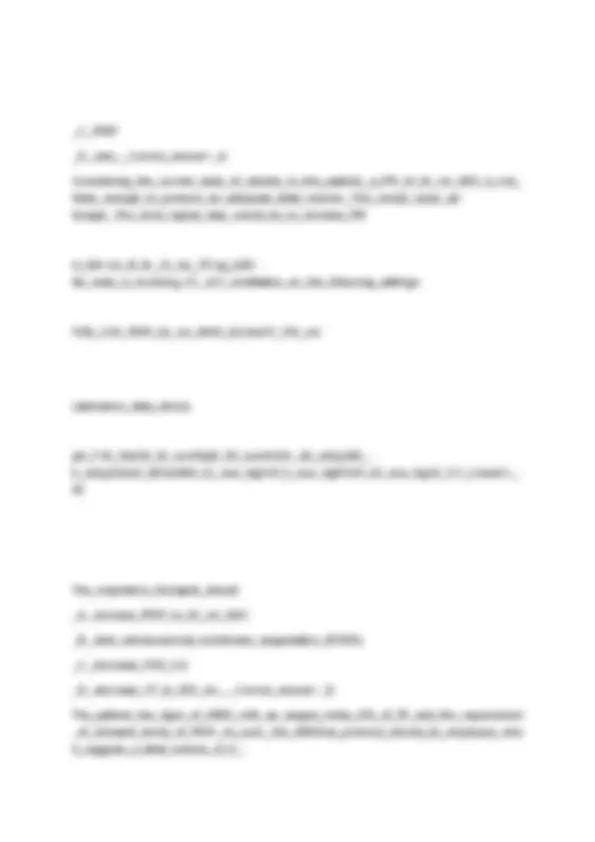
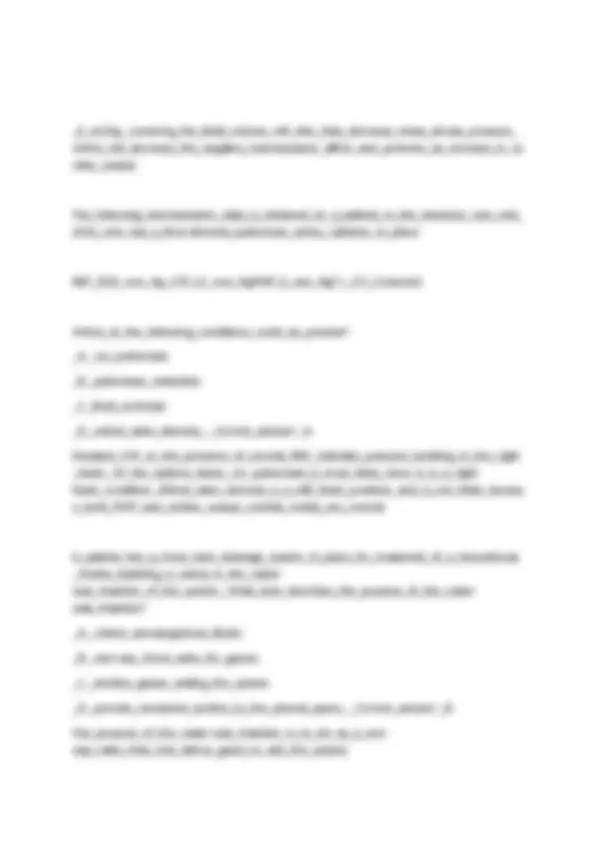
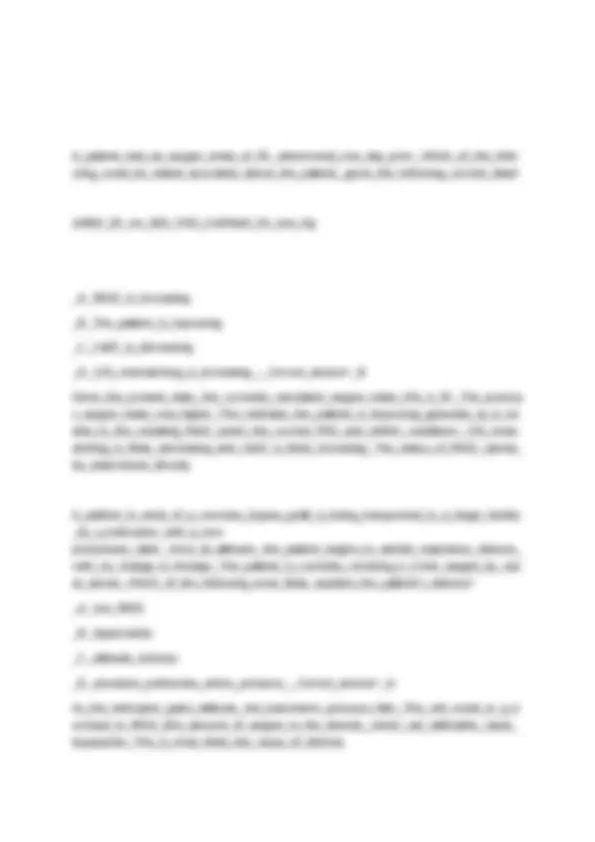
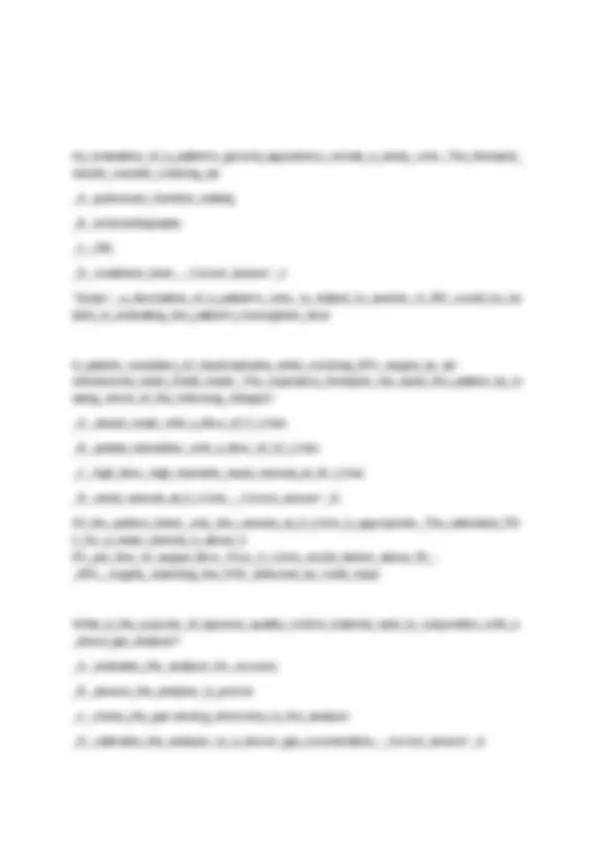
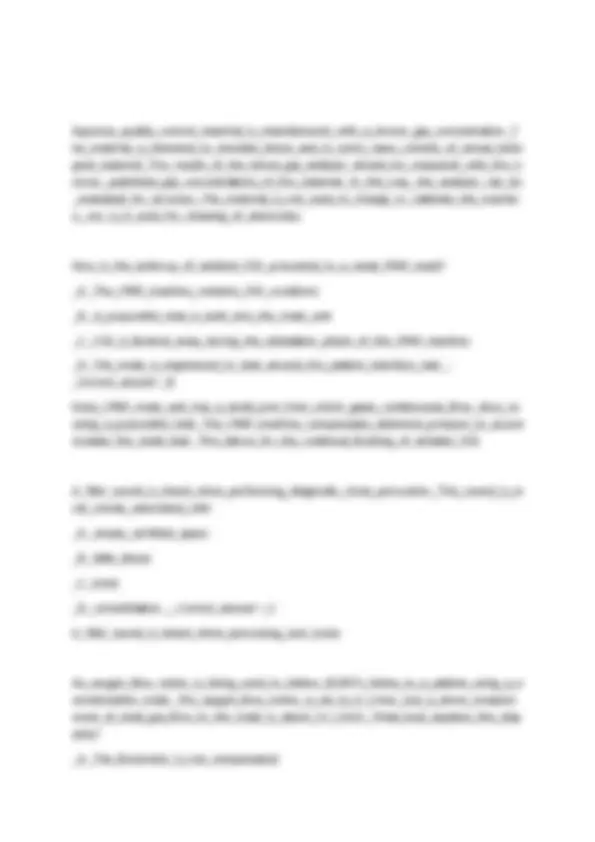
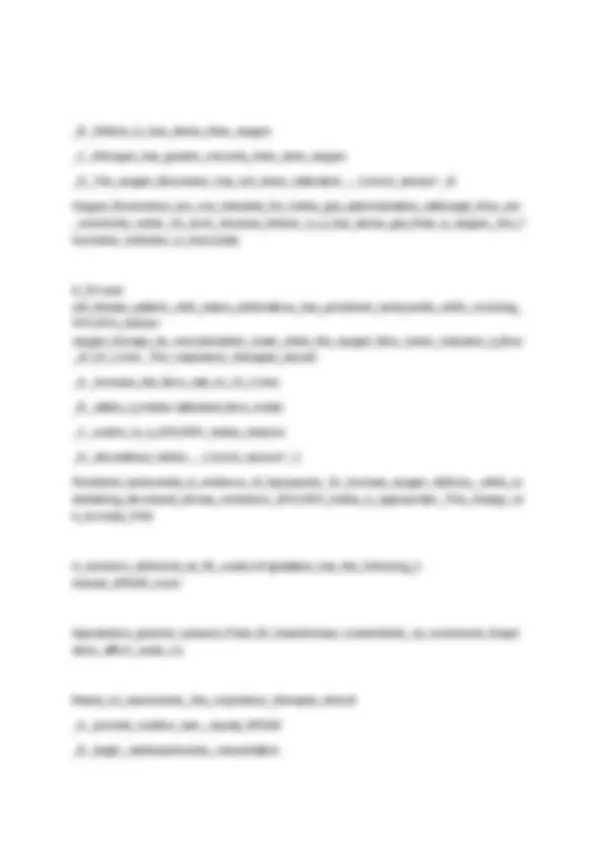
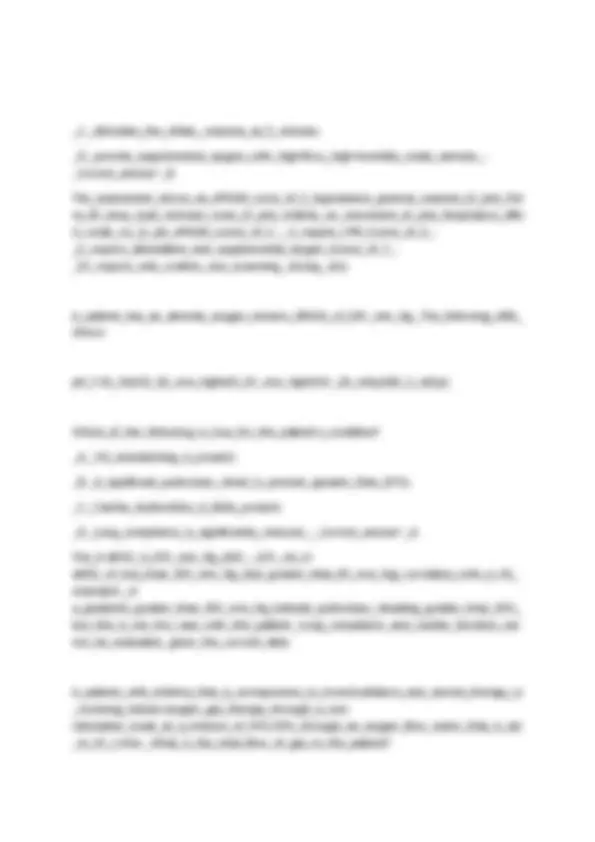
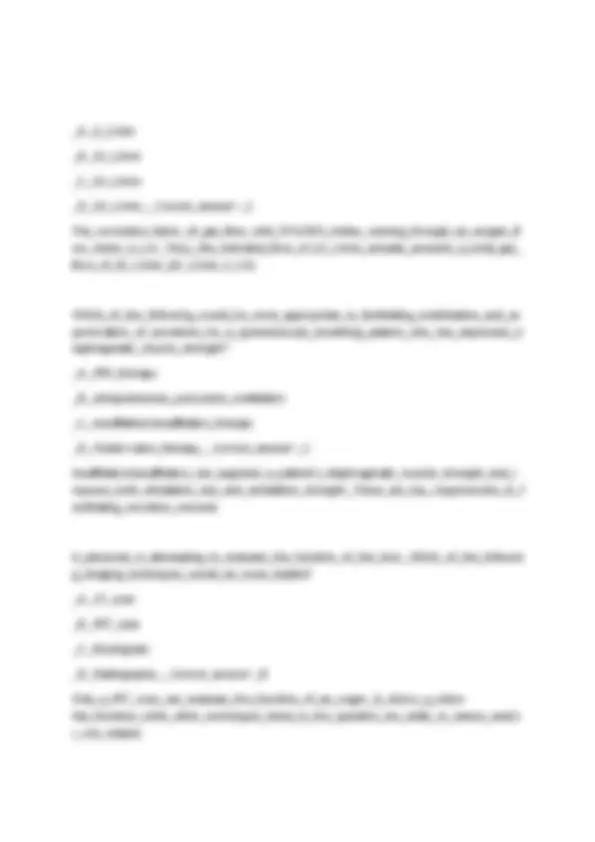
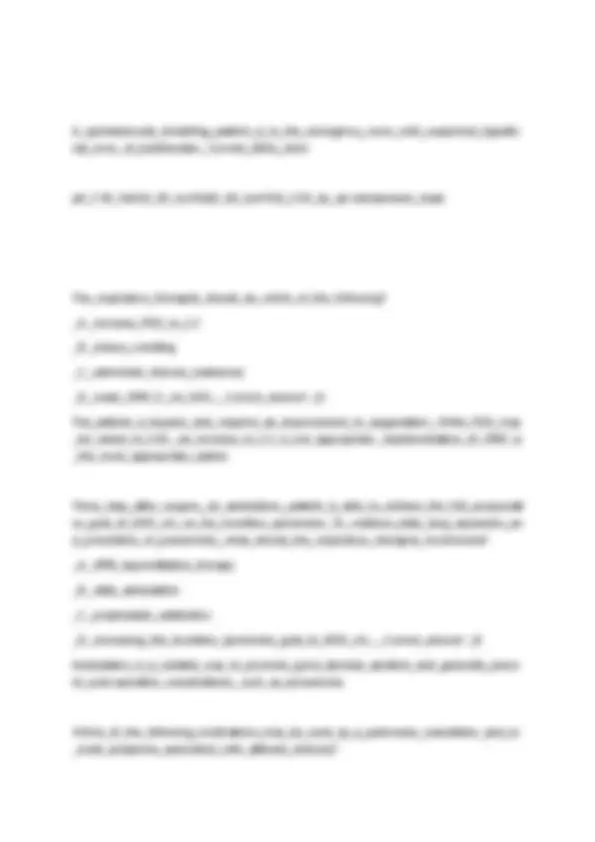
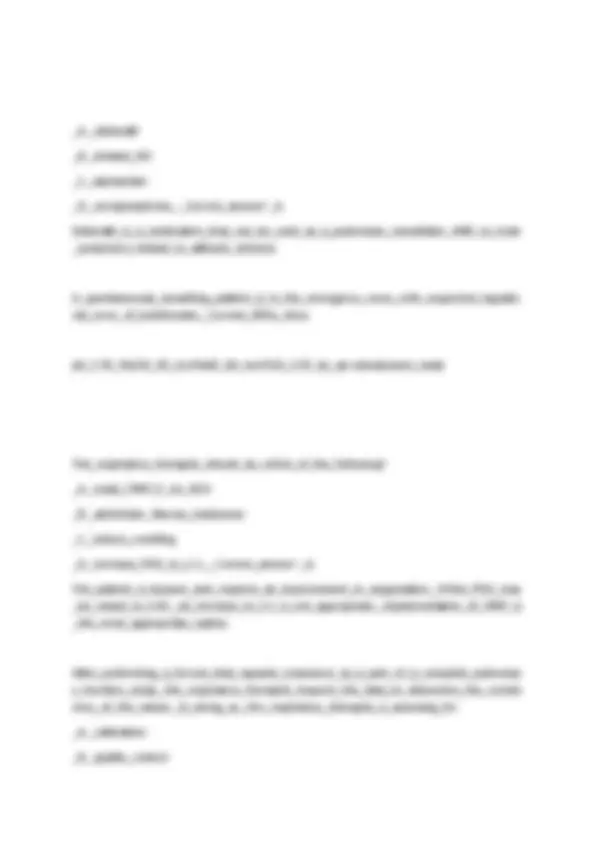
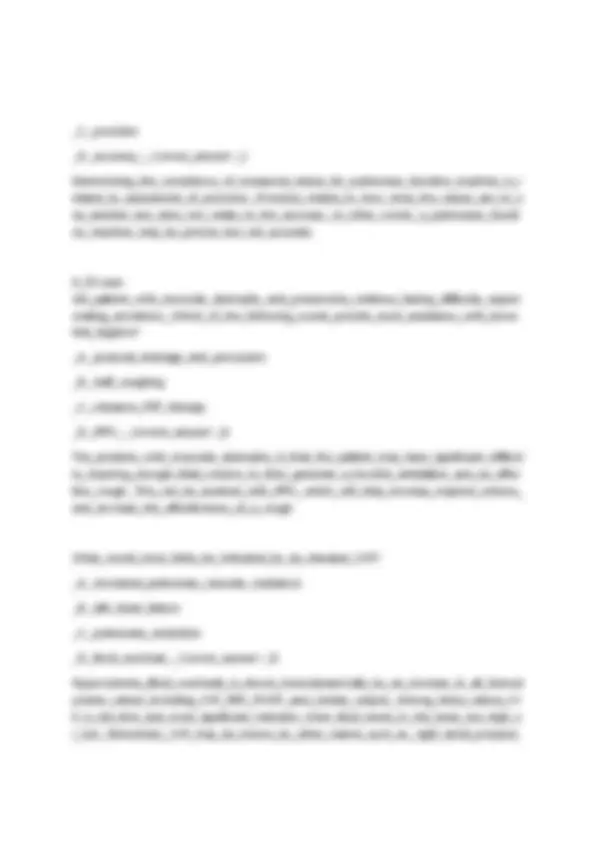
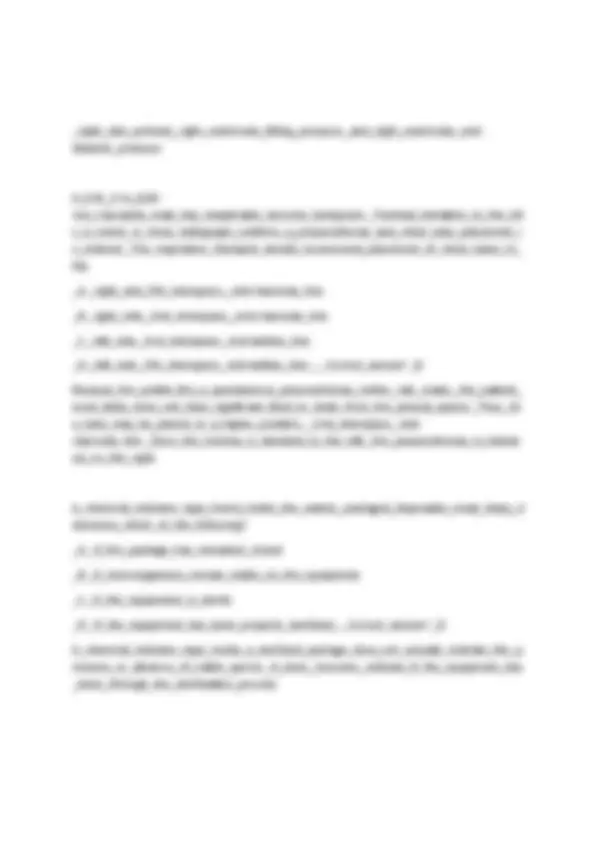
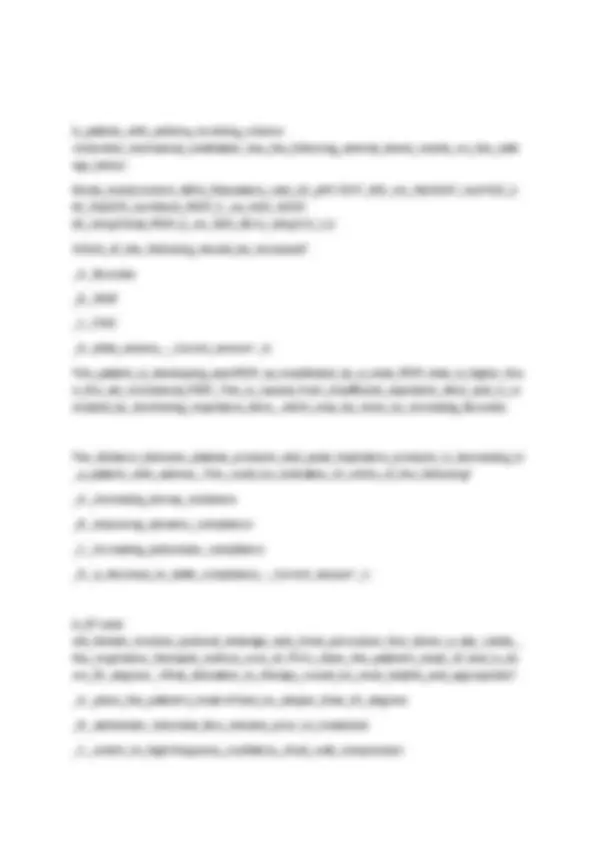
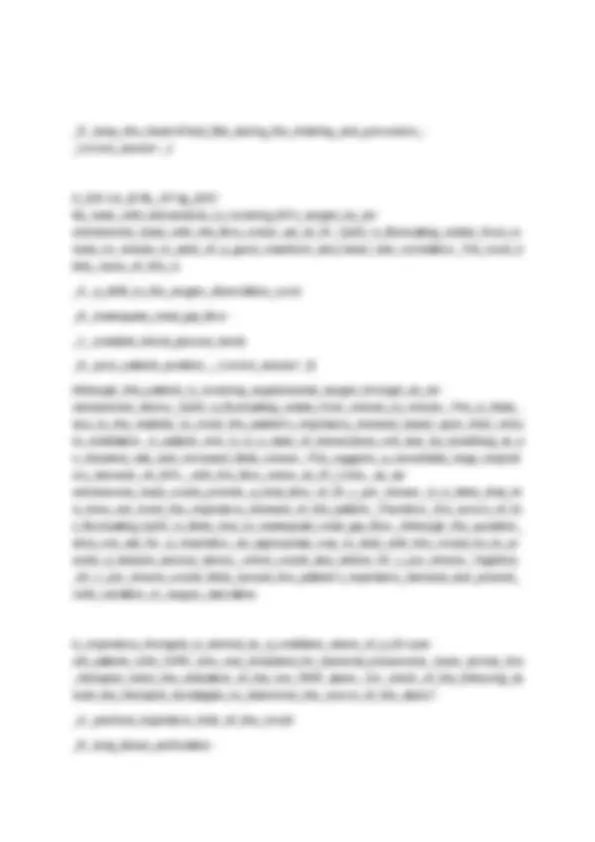
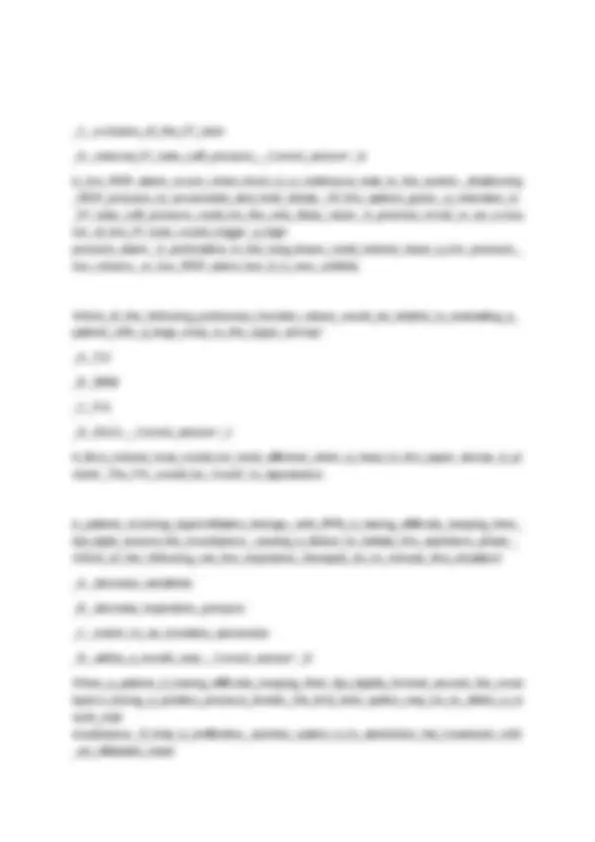
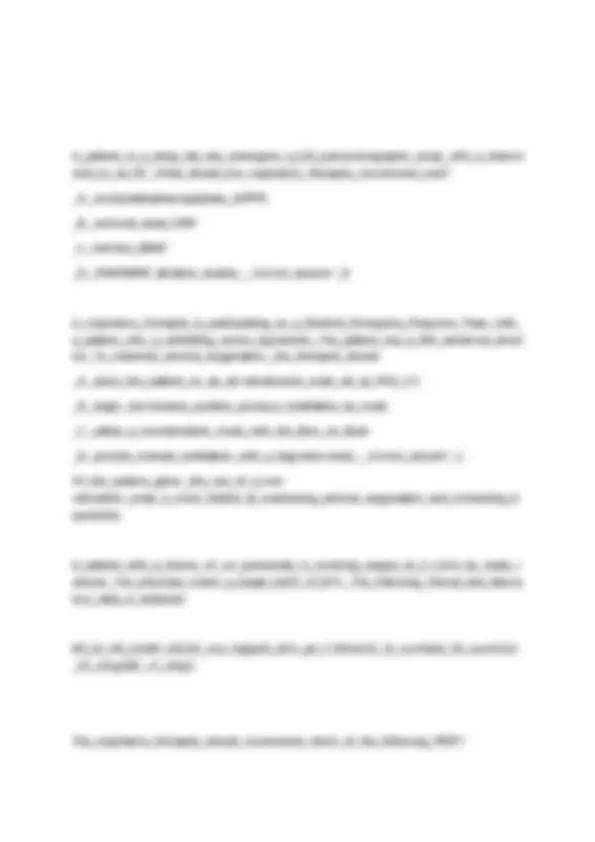
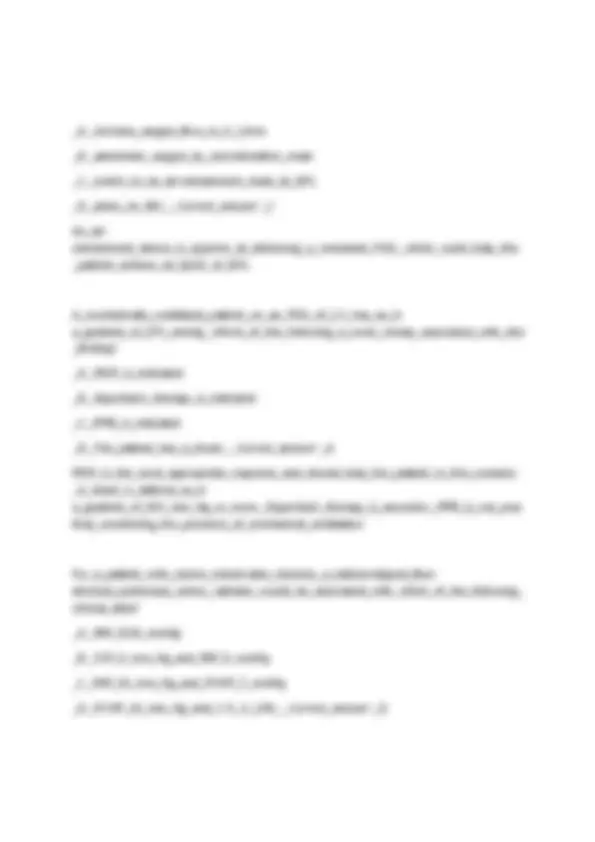
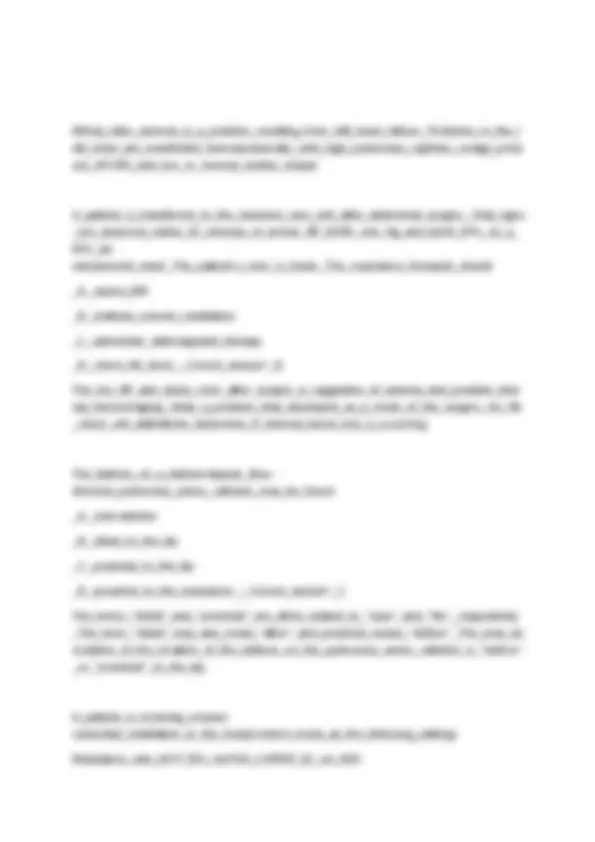
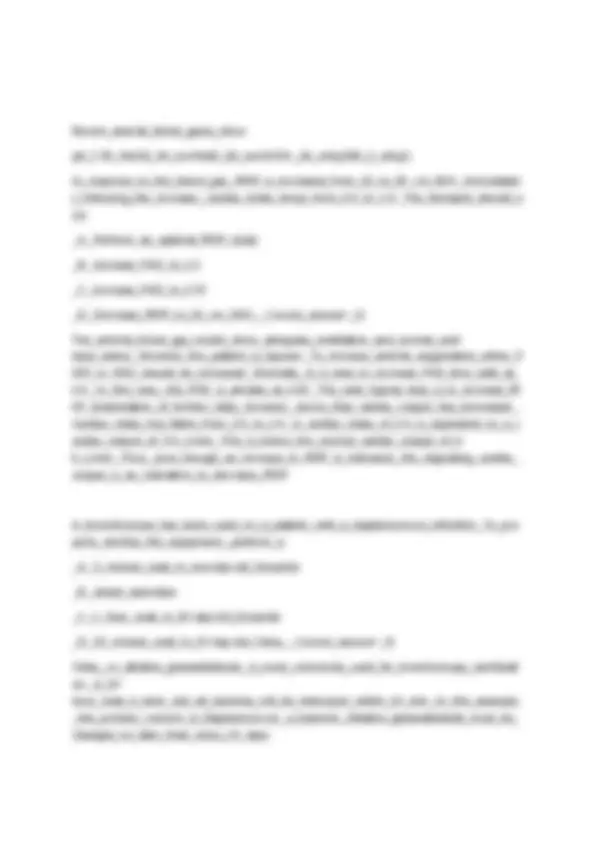
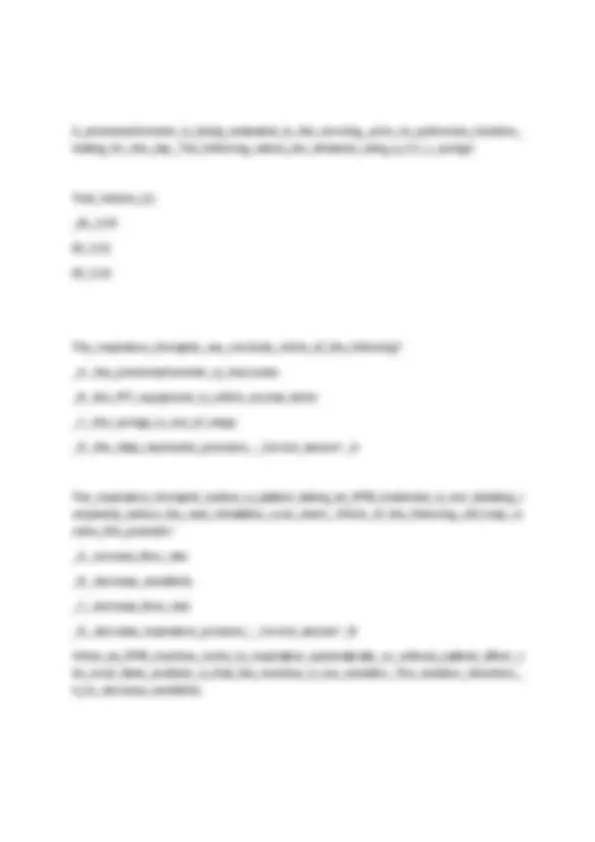
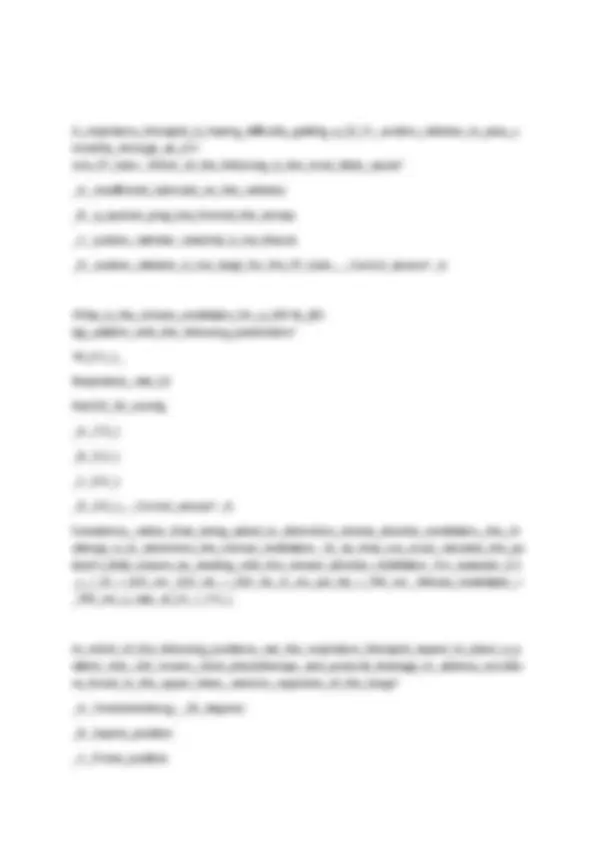
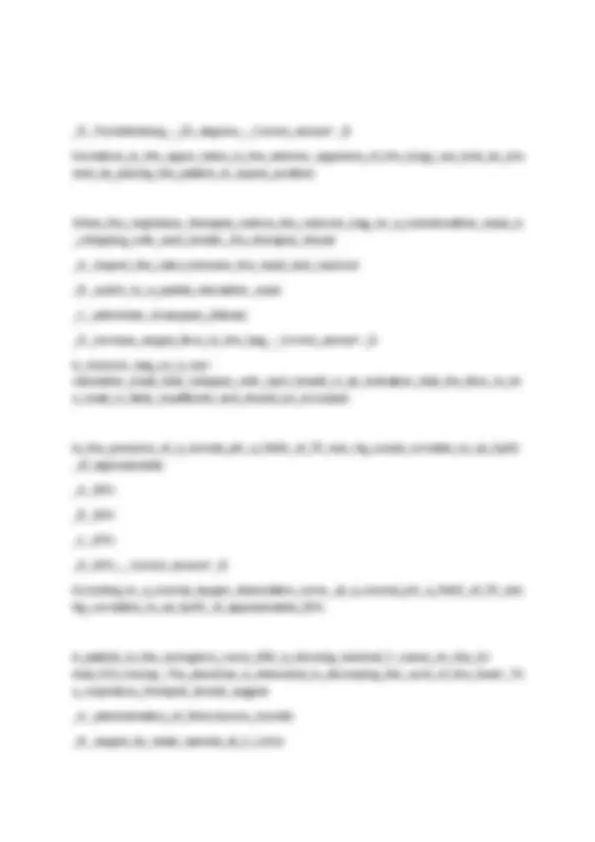
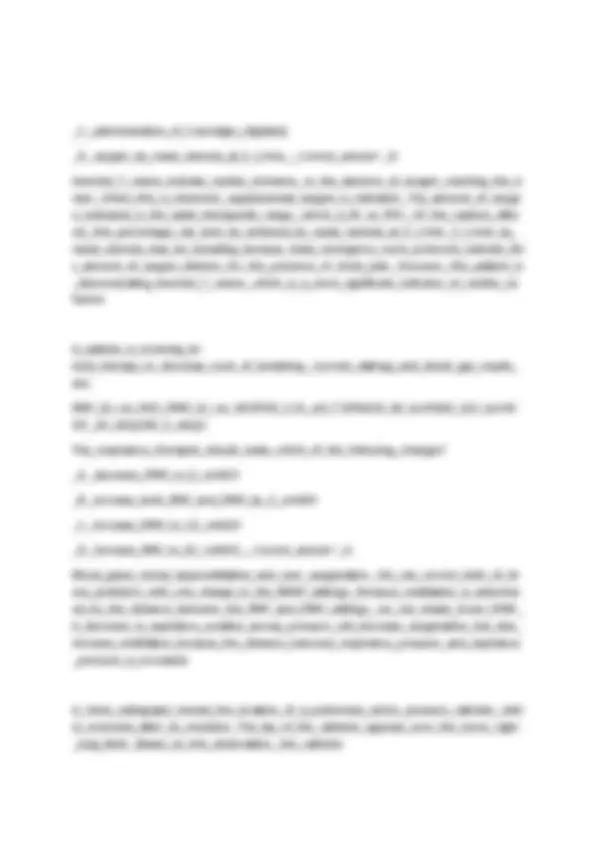
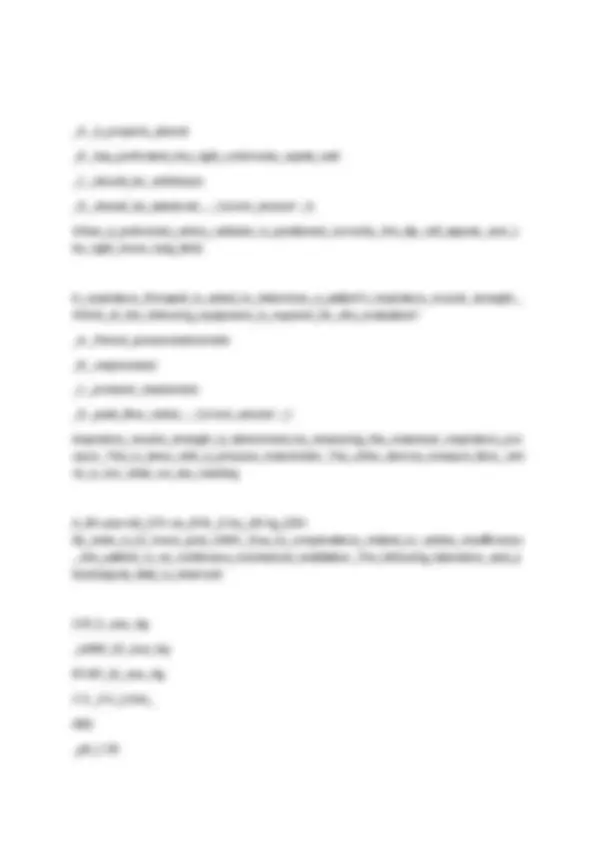
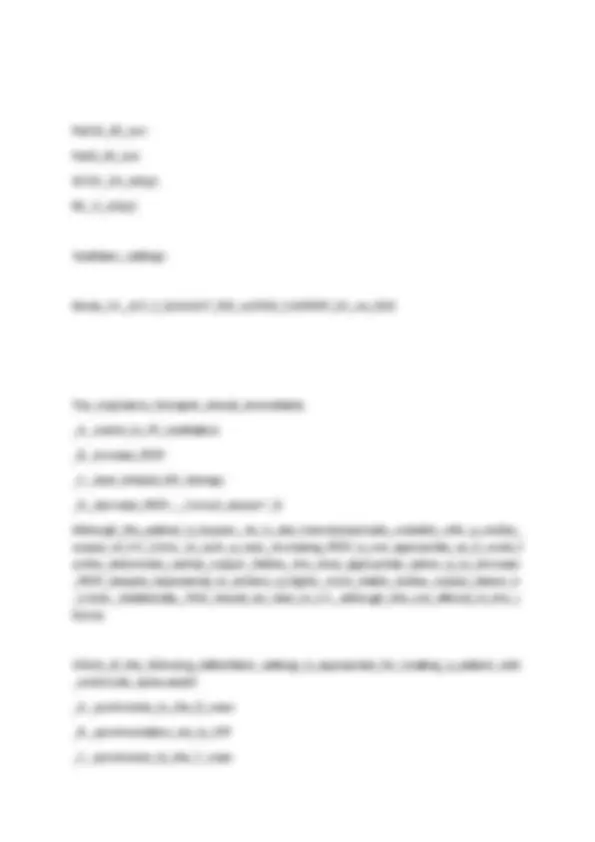


Study with the several resources on Docsity

Earn points by helping other students or get them with a premium plan


Prepare for your exams
Study with the several resources on Docsity

Earn points to download
Earn points by helping other students or get them with a premium plan
Community
Ask the community for help and clear up your study doubts
Discover the best universities in your country according to Docsity users
Free resources
Download our free guides on studying techniques, anxiety management strategies, and thesis advice from Docsity tutors
NBRC TMC PRACTICE QUESTIONS AND ANSWERS 100.pdf
Typology: Exams
1 / 173

This page cannot be seen from the preview
Don't miss anything!





























































































Which_of_the_following_is_needed_to_calculate_alveolar_oxygen_tension? A._VD/VT,_PAO B._BP_and_FiO C._PetCO2_and_PaO D._QS/QT,deadspace-_Correct_answer~_B. Barometric_pressure,FiO2,and_PaO2_are_all_included_in_the_formula(BP_stands_for barometric_pressure) L/min/m2_is_the_unit_of_measure_for: A._Systemic_vascular_resistance B.Cardiac_output C._Cardiac_index D.Stroke_volume-_Correct_answer~C. A_spontaneously_breathing_patient_has_the_following_arterial_blood_gas_results: pH_7.38_PaCO2 42 mmHgPaO2 76 mmHgHCO3- 24 mEq/LBE 0 _mEq/L
Which_of_the_following_supplemental_oxygen_levels_is_most_appropriate? A. 2 _L/min_nasal_cannula B. 5 _L/min_nasal_cannula _C._non-rebreathing_mask _D.Venturi_mask_at_30%-_Correct_answer~B. A_patient_who_is_showing_signs_of_hypoxemia_should_receive_supplemental_oxygen._If _the_patient_is_not_a_COPD_patient_and_the_situation_is_not_an_emergency,_then_the _proper_supplemental_oxygen_is_an_adult_therapeutic_dose,_which_is_40%_to_55%._Of the_options_available_only 5 _L/min_nasal_cannula_will_approach_this.Other_options are_either_insufficient_or_too_much. Left_heart_failure_would_be_manifested_in_which_of_the_following_values? _A._CVP_and_mPAP _B._mPAP_and_wedge_pressure _C._MAP_and_SVR _D.cardiac_output_and_wedge_pressure-_Correct_answer~D. The_function_of_the_left_heart,_specifically_the_left_ventricle,is_best_assessed_hemody namically_by_looking_at_those_values_that_precede_and_come_after_the_left_heart.In this_case_pulmonary_capillary_wedge_pressure_and_cardiac_output(or_cardiac_index)_a re_the_values_found_before_and_after_the_left_heart. Which_of_the_following_findings_is_most_closely_associated_with_increased_airway_resis tance? _A._reduced_SpO _B._accessory_muscle_use _C._altered_P _D.increased_PetCO2-_Correct_answer~_B.
_A.Administer_Dexamethasone(Decadron)_in_place_of_Albuterol _B._Add_Xopenex_to_the_bronchodilator_regimen _C.Replace_Albuterol_with_Beclamethasone(Beclovent) D.Switch_from_Albuterol_to_ipratropium_bromide(Atrovent)-_Correct_answer~_D. Because_albuterol_is_a_beta-agonist_medication,_patients_who_are_taking_beta- blockers_should_utilize_other_bronchodilation_medication. A_hospital_has_an_extremely_low_incidence_of_ventilator- associated_pneumonia._To_which_of_the_following_reasons_may_this_be_attributed? _A._periodic_discontinuation_of_sedation _B._use_of_respiratory_precautions_with_the_population _C._diversion_of_infectious_patients_to_other_facilities _D.broad_use_of_prophylactic_antibiotics-_Correct_answer~A. The_incidence_of_ventilator- associated_pneumonia,_or_VAP,_is_lowered_by_using_a_closed_system_suction_catheter, _periodically_discontinuing_sedation,_keeping_the_patient_and_semi- Fowler's_position,_and_proper_handwashing_among_caregivers.All_are_correct. A_pressure- volume_loop_ventilator_graphic_shows_no_rise_in_pressure_for_the_first 200 _mL_of_del ivered_volume._The_therapist_should _A._increase_inspiratory_flow_rate _B._increase_PEEP _C._decrease_tidal_volume _D.decrease_inspiratory_flow_rate-_Correct_answer~B. In_this_question_the_description_of_the_pressure_volume_loop_would_indicate_a_flat_b ottom_as_manifested_by_no_rise_in_pressure_with_the_first 200 _mL_of_delivered_volu me.We_call_this_a"flat_football"._The_solution_is_to_increase_PEEP_to_a_level_that_th e_pressure_begins_to_rise_immediately_as_volume_is_introduced.
Which_of_the_following_would_be_the_most_effective,_appropriate_method_for_resolvin g_atelectasis_in_a_spontaneously_breathing,_post_operative_patient_who_is_under_the_i nfluence_of_sedation_and_will_not_respond_to_verbal_stimuli? _A._IPPB _B.sustained_maximal_inhalation(incentive_spirometer) _C._deep_breathing_coaching _D.intubation_and_mechanical_ventilation-_Correct_answer~A. A_postoperative_patient_under_sedation,_and_possibly_in_pain,_may_be_tempted_to_br eathe_less,_causing_respiratory_acidosis_and_atelectasis._To_correct_this_problem,IPPB therapy_is_most_appropriate._Incentive_spirometry_would_also_help_but_the_patient_is unable_to_respond_to_verbal_stimuli.This_alone_is_an_indication_for_IPPB_therapy. After_performing_minimum_occluding_volume_technique_with_a 65 - kg(143- lb)_patient_who_is_orally_intubated_with_a_7.0- mm_ET_tube,_the_respiratory_therapist_should_NEXT _A._check_ET_tube_cuff_pressure _B._perform_tracheal_palpation _C._order_a_chest_radiograph _D.document_ET_tube_markings_at_the_lips-_Correct_answer~_A. The_ET_tube_cuff_pressure_may_be_adjusted_correctly_by_several_techniques_including minimum_leak_technique(also_called_minimum_occluding_volume,_minimal_seal_tech nique,_and_the_use_of_a_pressure_manometer_called_a_cuffalator._If_minimum_seal_or _minimal_leak_technique_is_used,_the_respiratory_therapist_is_still_required_to_monitor _the_pressure_after_the_technique_is_performed._Although_this_is_often_not_done_in_r eal_life,_it_is_technically_part_of_the_procedure. The_respiratory_therapist_observes_an_ECG_wave_form_on_a_patient_that_is_consistent _with_atrial_tachycardia._The_patient_is_complaining_of_chest_pain,_dizziness,_and_naus ea._The_respiratory_therapist_should_recommend
_C.vecuronium_bromide(Norcuron) _D.Mestinon-_Correct_answer~B. Morphine_sulfate_is_one_of_the_best_medications_to_administer_to_patients_receiving mechanical_ventilatory_support_to_help_the_patient_rest_pain- free_and_to_generally_sedate_and_relax_the_patient. A_patient_has_idiopathic_pneumonia_with_consolidation_in_the_right_lower_lobe.The physician_suspects_a_bacterial_infection._Which_of_the_following_will_provide_conclusiv e_data_to_rule_out_the_physician's_suspicions? _A._WBC _B._color_of_sputum _C._sputum_acid-fast_stain _D.oral_temperature-_Correct_answer~A. A_bacterial_infection_is_diagnosed_primarily_by_examining_the_white_blood_cell_count, _also_called_the_leukocyte_count._An_elevated_temperature_and_yellow_sputum_indicat e_the_possibility_of_an_infection_but_are_not_confirming_in_nature. After_making_the_universal_sign_of_choking,_a_person_collapses.The_observer_should FIRST _A._check_for_a_pulse _B._call_for_help _C._perform_abdominal_thrusts _D.administer 2 rescue_breaths-_Correct_answer~_C. When_a_person_indicates_the_universal_sign_of_choking,they_are_unable_to_verbalize because_there_is_likely_something_caught_in_their_airway._The_person_responding_mus t_first_focus_on_removing_the_obstruction,_which_is_done_by_performing_abdominal_th rusts.Administering_rescue_breaths_would_not_be_appropriate_because_the_airway_is obstructed._Calling_for_help_is_tempting_but_is_only_related_to_two- man_CPR._The_patient_is_not_yet_at_that_point._Performing_abdominal_thrusts_is_a_on e-man_maneuver_and_therefore_obtaining_additional_help_is_not_the_first_concern.
A_home_care_patient_calls_into_the_clinic_and_complains_that_his_oxygen_concentrator is_not_working_even_though_the_machine_is_plugged_in_and_the_switch_is_in_the'on '._Position._After_ensuring_the_patient_is_receiving_oxygen_from_a_reliable_alternate_so urce,_the_therapist_should_advise_the_patient_to _A._check_and_replace_the_internal_in-line_fuse _B._find_the_reset_switch_in_the_machine_and_press_it _C._ensure_the_circuit_breaker_is_in_the_on_position _D.change_the_filters_and_cycle_the_machine_off_then_on_again-_Correct_answer~_C. When_a_homecare_patient_reports_a_problem_with_their_oxygen_concentrator,the_firs t_action_should_be_to_ensure_the_patient_is_receiving_oxygen_from_an_alternate_sourc e(an_E_cylinder)._After_that_is_accomplished,_the_respiratory_therapist_may_instruct_t he_patient_in_some_basic_troubleshooting._This_includes_ensuring_the_device_is_plugge d_in,_changing_the_filter,_and_checking_the_circuit_breaker.All_other_troubleshooting_s hould_be_done_by_a_professional. An_adult_patient_with_asthma_is_receiving_Albuterol_by_small_volume_nebulizer_Q.I.D. at_a_dosage_of_0.5_mL._The_patient_complains_of_dizziness,_tingling_in_his_fingers,_an d_anxiety_with_each_treatment._The_therapist_should _A._increase_dosage_to_1.0_mL _B._decrease_dosage_to_0.15_mL _C._switch_to_Xopenex_0.63_mg _D.switch_to_Mucomyst_20%-_Correct_answer~_C. When_a_patient_experiences_an_adverse_reaction,_the_first_step_is_to_stop_the_therap y_and_then_modify_the_therapy_to_accomplish_the_same_objective._In_this_case,_decr easing_the_dose_of_Xopenex_is_suitable_because_0.63_mg_is_still_in_the_adult_therape utic_range. Which_of_the_following_conditions_would_benefit_most_from_a_thoracentesis? _A._atelectasis
_A._Use_of_pressure_support _B._Switch_to_pressure_control_ventilation _C._Increase_the_machine_flow_rate _D.Increase_PEEP-_Correct_answer~A. During_ventilator_weaning,_a_patient_must_maintain_a_moderately_low_respiratory_rate ,_an_adequate_sized_tidal_volume,_and_low_work_of_breathing._In_this_case,_the_patie nt_is_experiencing_increased_labor_of_breathing_and_an_increase_in_respiratory_rate._T his_is_likely_due_to_a_reduced_spontaneous_tidal_volume._Although_this_data_is_not_s hown,_this_condition_can_be_assumed.The_solution_for_a_low_spontaneous_tidal_volu me_and_increased_work_of_breathing_during_weaning_is_to_provide_pressure_support. When_analyzing_the_FIO2_for_an_infant_in_an_oxygen_hood_receiving_oxygen_therapy with_a_blender_set_at_50%,the_respiratory_therapist_notes_an_oxygen_concentration of_35%_near_the_patient's_mouth.The_jet_nebulizer_entrainment_setting_is_set_to 50 %._To_correct_the_problem,_the_therapist_should _A._adjust_blender_setting_to_60% _B._increase_total_flow_to_the_oxyhood _C._obtain_a_smaller_oxyhood _D.change_the_nebulizer_entrainment_port_to_100%-_Correct_answer~_D. When_administering_oxygen_by_oxygen_hood_with_a_blender_and_a_nebulizer,_the_oxy gen_control_on_the_nebulizer_should_be_set_to_100%._This_will_prevent_additional_ent rainment_of_room_air_which_will_cause_a_decrease_in_FIO2. Following_the_insertion_of_a_tracheostomy_tube,_the_patient_is_found_to_have_diffuse _crackles_upon_auscultation_secondary_to_subcutaneous_emphysema._Which_of_the_fol lowing_radiographic_findings_would_be_expected_with_this_condition? _A._Hyperlucency_in_the_soft_tissues _B._Diffuse_pulmonary_hyperlucency _C._Tracheal_shift_from_midline _D.Scattered_patchy_infiltrates-_Correct_answer~_A.
Hyperlucency,_seen_on_a_chest_x- ray_is_darker_in_color._Air_is_radiolucent._Therefore,_air_located_in_the_soft_tissue,as seen_with_subcutaneous_emphysema_would_result_in_a_hyperlucent_X- ray_over_soft_tissue_areas._Subcutaneous_emphysema_by_itself_will_not_shift_the_trach ea_from_midline._Scattered_patchy_infiltrates_are_associated_with_ARDS,not_subcutane ous_emphysema. Placement_of_a_pulmonary_artery_catheter_is_associated_with_which_of_the_following most_common_complications? _A._hypotension _B._pulmonic_valve_damage _C._cardiac_arrhythmias _D.internal_bleeding-Correct_answer~C. Several_complications_may_arise_from_the_placement_of_a_pulmonary_artery_catheter, otherwise_called_a_Swan- Ganz_catheter._The_development_of_cardiac_arrhythmias_is_the_most_common_complic ation_of_the_options_offered.Another_serious_complication_is_perforation_of_a_vessel or_cardiac_muscle_during_the_insertion. A_galvanic_fuel_cell_oxygen_analyzer_may_read_erroneously_high_under_which_of_the_f ollowing_conditions? _A._when_the_analyzer_batteries_are_depleted _B._during_a_sudden_increase_in_the_partial_pressure_of_oxygen _C._when_a_volume-controlled_ventilator_at_high_inspiratory_pressures _D.when_liquid_gets_on_the_membrane-_Correct_answer~_C. A_galvanic_fuel- cell_oxygen_analyzer_may_read_erroneously_when_ambient_pressures_change_significant ly,_such_as_when_a_patient_is_receiving_high_inspiratory_pressure_or_when_a_patient_c hanges_altitude_quickly.
_D.oxygen_consumption_at_the_tissues-_Correct_answer~C. Oxygen_transport_refers_to_the_ability_for_blood_to_carry_oxygen_from_the_alveoli_to the_tissues._In_a_case_involving_carbon_monoxide_poisoning,_it_is_transport_that_is_m ost_affected._This_is_true_because_hemoglobin_becomes_occupied_with_carbon_monoxi de_rather_than_oxygen.Hemoglobin_is 19 times_more_attracted_to_carbon_monoxide compared_to_oxygen._Of_the_options_listed,_the_best_method_to_monitor_the_adequac y_of_oxygen_transport_would_be_to_evaluate_the_arterial_oxygen_content._This_value_t akes_into_account_the_amount_of_oxygen_tied_to_the_hemoglobin_as_well_as_the_oxyg en_dissolved_in_the_plasma_of_the_blood A_patient_complains_of_shortness_of_breath_during_a_nebulizer_treatment_is_hypertoni c_saline._The_respiratory_therapist_should_do_which_of_the_following? _A._Discontinue_therapy_and_notify_the_physician _B._Add_Albuterol_to_the_nebulizer_treatment _C._Switch_to_normal_saline _D.Switch_to_hypotonic_saline-_Correct_answer~_A. Adverse_reactions_during_any_therapy_should_be_responded_to_initially_by_discontinuin g_therapy_and_notifying_the_physician. In_preparation_for_a_helium_dilution_study,_a_respiratory_therapist_is_calibrating_the_h elium_analyzer._While_exposing_the_analyzer_to_ambient_room_air,_what_will_the_analy zer_read_for_helium_concentration? _A._21% _B._0% _C._2% _D.79%-_Correct_answer~_B. To_calibrate_a_helium_analyzer,_sometimes_called_a_Wheatstone_Bridge,_the_device_m ust_be_calibrated_to_room_air_for_the_low_calibration_and_to_a_known_level_of_heliu m_for_the_high_calibration._Because_room_air_has_no_significant_level_of_helium,_heliu m_analyzers_should_read_0%_when_exposed_to_ambient_room_air_conditions.
Which_of_the_following_will_result_in_a_decrease_in_mean_airway_pressure_for_a_patie nt_on_a_mechanical_ventilator_in_the_assist/control_mode? _A._use_of_expiratory_retard _B._institution_of_a_1.0_sec_inspiratory_plateau _C._decrease_in_inspiratory_time _D.decreasing_inspiratory_flow-_Correct_answer~_C. Decreasing_inspiratory_time_will_lower_the_amount_of_time_a_patient_is_exposed_to_p ositive_pressure_and_will_therefore_result_in_a_decrease_in_mean_airway_pressure._Use _of_expiratory_retard,_increasing_inspiratory_flow,_and_institution_of_an_inspiratory_plat eau_will_all_lead_to_increased_mean_airway_pressure. A_chest_radiograph_of_an_abdominal_post- operative_patient_shows_abnormal_elevation_of_the_left_hemidiaphragm._Which_of_the _following_conditions_explains_the_observation? _A._pneumothorax_on_the_left _B._herniation_of_the_left_hemidiaphragm _C._hemothorax _D.atelectasis_in_the_left_lower_lobe-_Correct_answer~_D. Abnormal_elevation_of_the_left_hemidiaphragm_is_an_indication_that_the_lung_on_that _side_is_smaller_for_some_reason._This_could_be_due_to_a_partial_pneumothorax_or_p rofound_atelectasis._Oftentimes,_atelectasis_can_develop_as_a_result_of_surgery._Theref ore,_the_raised_hemidiaphragm,_combined_with_the_postoperative_status_of_the_patien t,_indicate_the_most_likely_problem_is_atelectasis_in_the_left_lower_lobe. Immediately_following_oral_endotracheal_intubation,_the_respiratory_therapist_should_c onfirm_proper_placement_by_doing_which_of_the_following? _A._Assess_end-tidal_CO2_with_a_colorimetric_capnometer _B._Obtain_a_anterior-posterior_chest_radiograph
C.Impending_ventilatory_failure D.Myasthenia_gravis-_Correct_answer~A. Of_the_options_listed,_only_the_suspicion_and_evidence_of_pulmonary_embolism_is_sug gestive_of_and_emergency_and_necessitates_the_use_of_FiO2_1. For_a_patient_who_is_unconscious,_due_to_ingestional_error_of_barbiturates,which_of the_following_assessments_is_the_most_important? A.Arterial_blood_gas_analysis B.The_patient's_ability_to_protect_their_airway C._Tension_test D.A_drug_toxicology_screen-_Correct_answer~_B. Which_of_the_following_types_of_patients_are_most_often_good_candidates_for_alveola r_recruitment_maneuvers? 1.Post-surgical 2.Acute_lung_injury 3._Pulmonary_emphysema 4.Acute_respiratory_distress_syndrome 5.Tuberculosis A._1,_2,_3,and 4 only B._1,_2,and 3 only C._1,_3,and 5 only D._3,_4,and 5 only-_Correct_answer~_A. Which_of_the_following_is_most_attributed_to_effective_alveolar_recruitment?
Effective_alveolar_recruitment_will_be_manifested_by_which_of_the_following_clinical_ou tcomes? 1._Decrease_in_the_A-a 2.Increase_in_PF_ratio 3._Decrease_in_VT 4._Decrease_in_Qs/Qt A.1,2,and 4 only B. 1 and 4 only C. 2 and 3 _only D._1,_2,_3,and 4 _-_Correct_answer~_A. Which_of_the_following_PEEP_levels,_set_above_the_patient's_plateau_pressure,is_appr opriate_as_an_initial_setting_during_alveolar_recruitment_maneuvers? A. 10 cm_H2O B. 40 cm_H2O C. 30 cm_H2O D. 20 cm_H2O-_Correct_answer~_A. Which_of_the_following_ventilator_modes_is_most_suitable_to_help_recruit_alveoli? A._PRVC B._PCV C._APRV D.Inverse_positive_pressure_ventilation-_Correct_answer~_C.
To_qualify_for_ventilator_weaning,_a_patient's_Qs/Qt_should_be_below A.60% B.5% C.10% D.20%-Correct_answer~D. A_patient_receiving_VC_SIMV_ventilation_has_a_spontaneous_tidal_volume_of 500 mL and_a_respiratory_rate_of_20/min_when_removed_momentarily_from_the_ventilator.W hat_is_the_RSBI_value? A. 10 B. 25 C. 40 D.0.025-Correct_answer~C. RSBI_is_calculated_by_RR/VT(L). RSBI= 20 /0.5_L RSBI= 40 To_be_considered_for_weaning_from_VC_A/C_ventilation,a_patient's_A- aDO2_should_be_less_than: A. 100 mm_Hg B. 65 mm_Hg C. 300 mm_Hg D. 200 mm_Hg-_Correct_answer~C.